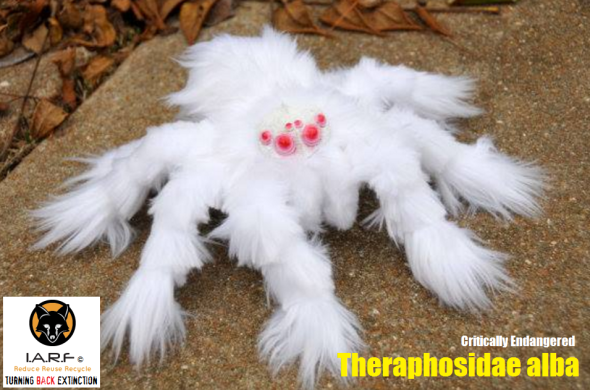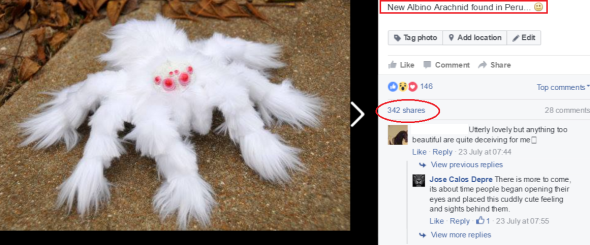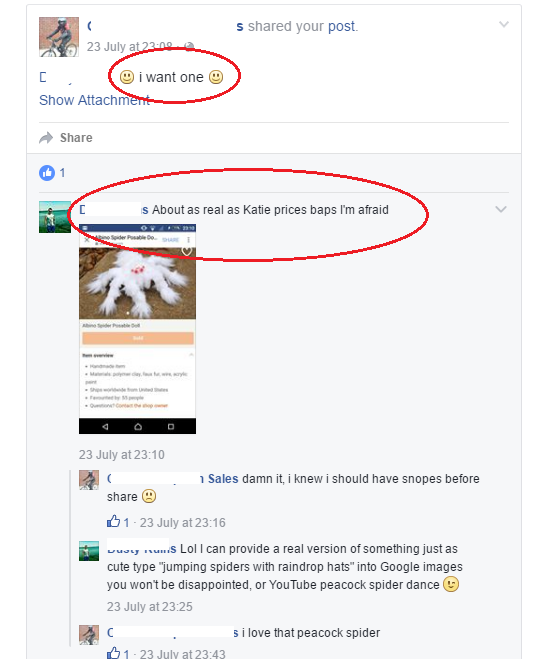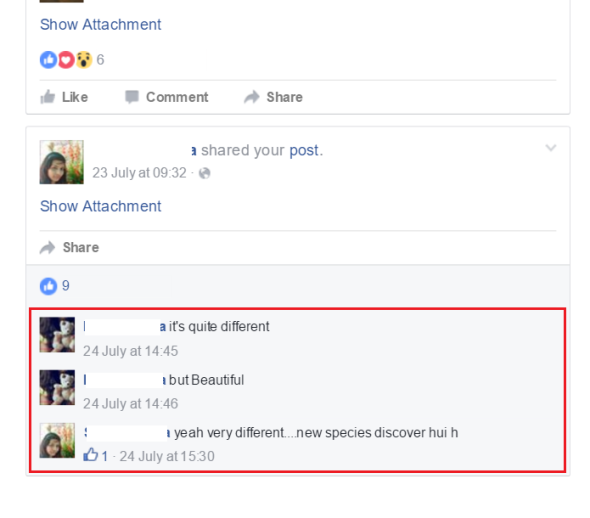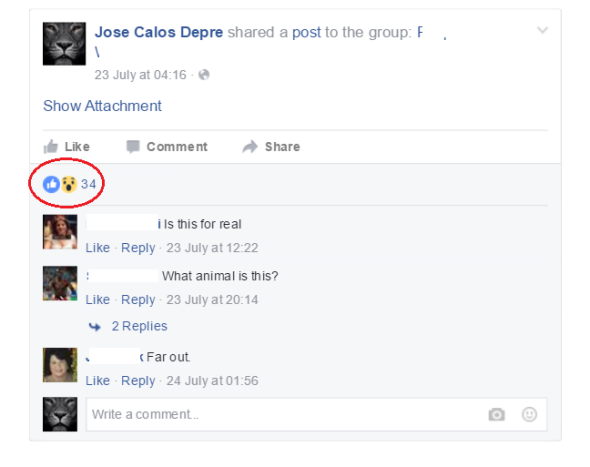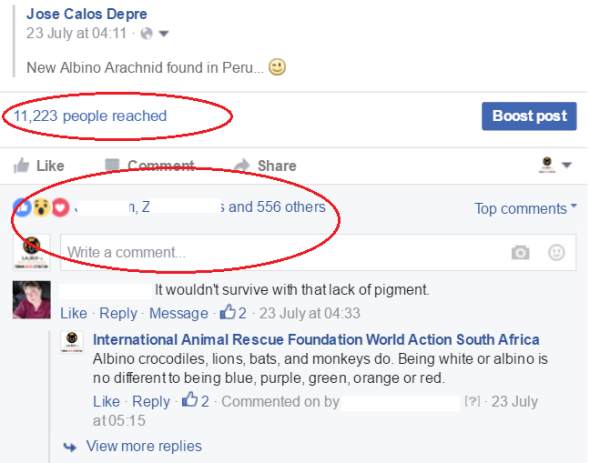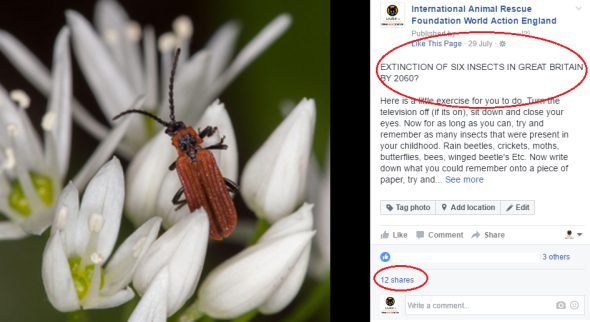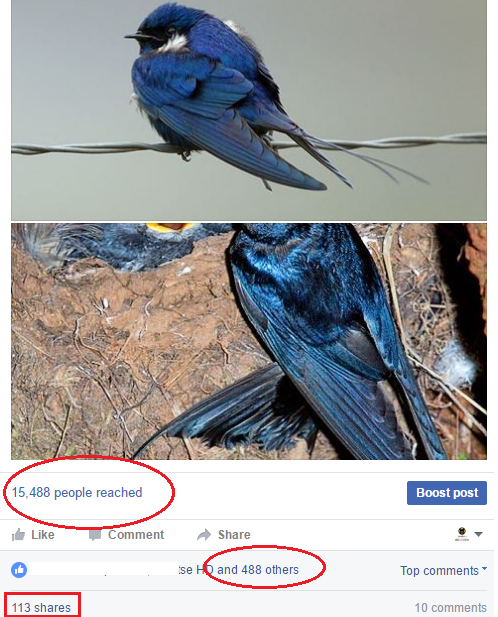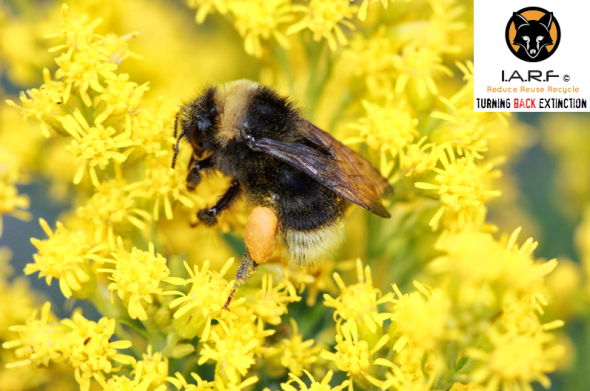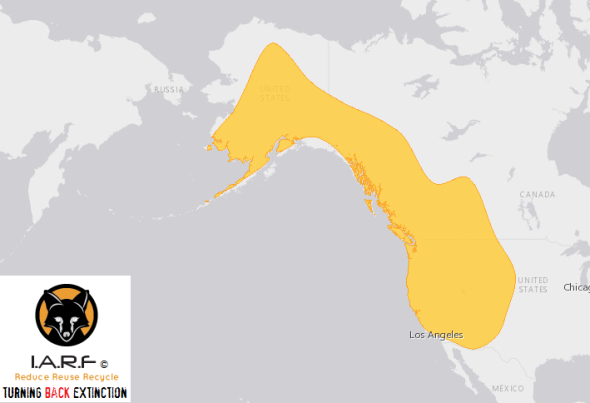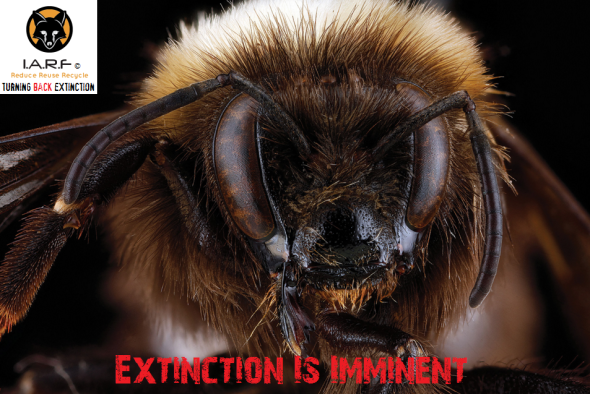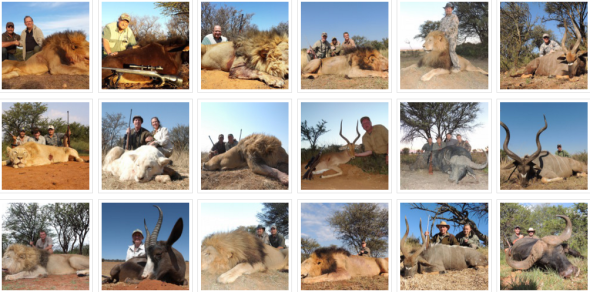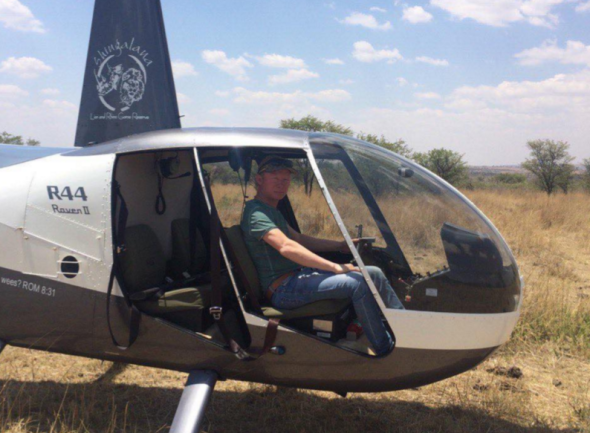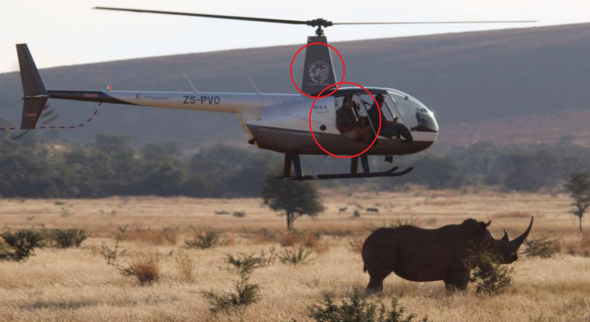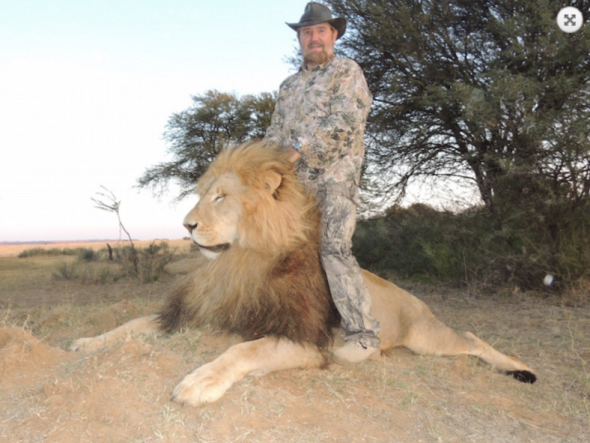SHOULD VIET NAM BE SLAPPED WITH TRADE SANCTIONS? | ILLEGAL WILDLIFE TRADE.

SHOULD VIET NAM BE SLAPPED WITH FULL TRADE SANCTIONS?
Since 2012 International Animal Rescue Foundation Africa’s (Cyber and Environmental Crimes Team) have been investigating Viet Nam’s illicit and illegal wildlife trade more closely than we’ve ever done. Back in January 2015 I Dr Jose C. Depre the (CEO) ordered a meeting with both units from the Environmental Cyber Crimes Team and External Affairs Unit); both focusing on the ground and online trade of illegal wildlife contraband. My aim was to increase both online and ground team investigations to begin breaking the back of these ruthless criminals throughout Asia and Africa.
International Animal Rescue Foundation Africa since founded have conducted 1,033 investigative surveys relating to all areas Viet Nam’s illegal wildlife trade (online and ground trade). However it wasn’t until January 2015 after uncovering a colossal rhino horn trafficking ring within Thailand and Viet Nam that we eventually decided Viet Nam had to be investigated more in-depth - all of which has resulted in a number of arrests and confiscation orders this year alone. The ongoing investigation was ordered due to a suspicion that the illicit ivory trade was increasing in Viet Nam too. Furthermore various organisations, media and press had stated that Viet Nam’s wildlife trade was actually decreasing, neither of which was true!.
I.A.R.F.A’s investigations aren’t just focused on Viet Nam. Specialist teams locate traffickers, suppliers and even poachers. These highly trained investigative officers move from one country to the next discretely monitoring and following various traffickers and kingpins (not forgetting befriending others too - which in many cases can be quite dangerous). While most of our investigations have focused primarily on Viet Nam, China, Thailand, Laos, Japan and Malaysia. Investigative officers have also been working within Uganda, Angola, South Africa, Namibia, The Democratic Republic of the Congo, South Sudan, Niger, Nigeria and Burkina Faso (among many other countries).
In four days time South Africa will be hosting the next Conference of Parties (CoP17). The Convention on International Trade in Endangered Species of Wild Flora and Fauna (CITES), that now hosts some 184 CITES signatories which will be debating numerous issues relating to both flora (plants) and (fauna) animals. The meeting will take place from the 24th September to the 5th October (2016). Back in 2011 Interpol estimated the extent of the illegal wildlife trade between $10 billion and $20 billion per year. This figure has gradually increased since 2014.
The illegal wildlife trade isn’t confined to just one country. Many countries around the world host wildlife trafficking and dealing routes extending to every continent. Conservationists say the problem is most acute in Southeast Asia. There, trade linkages to key markets in China, the United States, and the European Union; lax law enforcement; weak border controls; and the perception of high profit and low risk contribute to large-scale commercial wildlife trafficking. The ASEAN Wildlife Enforcement Network (ASEAN-WEN) ASEAN Wildlife Enforcement Network, supported by the U.S. Agency for International Development and external funders, is one response to the region’s illegal wildlife trade networks.
Figures from 2014-2015 have shown a startling increase relating to the funds generated from the illegal wildlife trade. Today illegal wildlife trade is estimated to be worth US$50-150 billion per year. The global illegal fisheries catch is valued at US$10-23.5 billion a year and illegal logging, including processing, at US$30-100 billion. (Source: Illegal Wildlife Trade 2014-2015). So as one can see no matter how many meetings we’ve been holding the illegal wildlife trade is skyrocketing to levels that we’ve never seen before. The question is though, how do we as environmentalists stop this, how can we force violating countries to take notice?
International Animal Rescue Foundation Africa have been calling on CITES for more than five years now to impose trade sanctions against offending countries. Unfortunately CITES and their signatories haven’t in our opinion taken a blind bit of notice, especially when it comes to Viet Nam that has been blacklisted as ‘possibly the largest threat to global wildlife on the planet?’. A trade sanction (which is what we want placed against Viet Nam and other offending countries) is a trade penalty imposed by one nation onto one or more other nations. Sanctions can be unilateral, imposed by only one country on one other country, or multilateral, imposed by one or more countries on a number of different countries. Often allies will impose multilateral sanctions on their foes.
From 2015 we (the organisation) have located a staggering $13.5 million (USD) of illegal wildlife contraband - most of which is being traded online via various forums such as Facebook within secret groups. (You can view a some of the contraband we investigative via our Facebook page here). On speaking to numerous traders to try and understand why this trade was being conducted on line; the traders have always stated: (Its more safer to trade, they can trade to a wider market without the need to carry their products over many miles. Finally, its quicker to trade into large private buy and sell forums anything that would be deemed ‘hot to handle’ such as Rhinoceros horn, elephant ivory, and pangolin parts (Etc).

Image: Mr Tuan advertises the authenticity of recently smuggled rhino horn 11th August.
I.A.R.F.A have located over 21 African Rhinoceros horns traded illegally online and via ground markets since 2015 when we began our new anti wildlife trade operations and, 9 Indian One Horned Rhinoceros horns (all authentic). Mr Tuan, a Vietnamese national had no qualms whatsoever proving the legitimacy of his recently smuggled horn from South Africa. Anti Wildlife Trade Officers were invited to Mr Tuan’s Hanoi antiques shop of which in the back room were four recently poached Rhinoceros horns. I.A.R.F.A Anti Wildlife Trade Officers posing as interested buyers were offered the above in liquid form as a ‘so called aphrodisiac’.
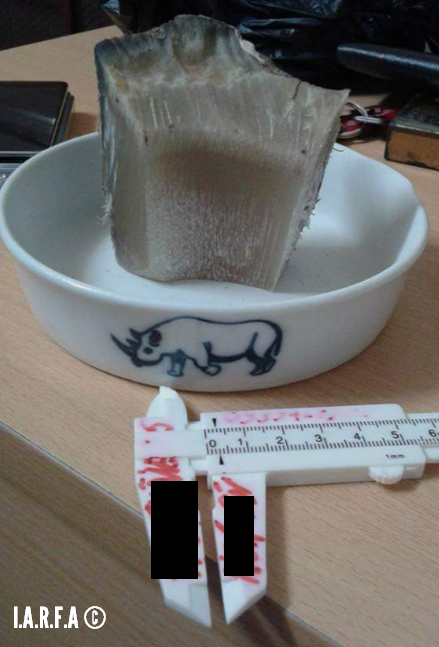
Image: Mr Tuan prepares to sell this horn to I.A.R.F.A investigators.
The above horn was measured up, weighed and offered to I.A.R.F.A investigative officers for a total of $4,000(USD). While the officers declined a small sample was purchased so that we could test the authenticity of this horn. Vietnamese investigative officers working with (I.A.R.F.A) the very next day took the sample to Viet Nam National University of which tests later revealed the horn originated from an African Rhinoceros based on the horns DNA.

Image: One of Viet Nam’s many Rhino horn kingpins. Mr Tuan.
While we don’t make a habit of exposing ‘wealthy wildlife trade kingpins’. As we’re nearing the (CoP17 summit) we believe its time to begin naming and shaming some of the dons behind this ruthless trade in order to communicate our message far and wide to all CITES members that enough is enough, sanctions must be placed against all violating countries. Mr Tuan doesn’t just deal in large quantities of authentic Rhinoceros horn neither. Ivory, pangolin parts and the critically endangered Indochinese Box Turtle also fill Mr Tuan’s home and antiques shop. So Mr Tuan if you’re reading please do say cheese.
Meanwhile Mr Tuan is just a small piece of the ever-increasing illegal wildlife trade iceberg. In one group that we’ve been monitoring for over two years that’s yielded 9 arrests thus far this year (which we cannot name for legal reasons). Some 33,000 individuals all over the globe are trading ivory, tiger parts, bear claws, pangolin scales and critically endangered moon bear skins (among many other items). The vast majority of these online traders that lead investigative officers to some ground locations are either Vietnamese, Chinese, Malaysian, Indonesian, Indian, Belgium, Australian, American and Canadian traders. One trader was even located in London W12, and two others dealing from Paris, France.
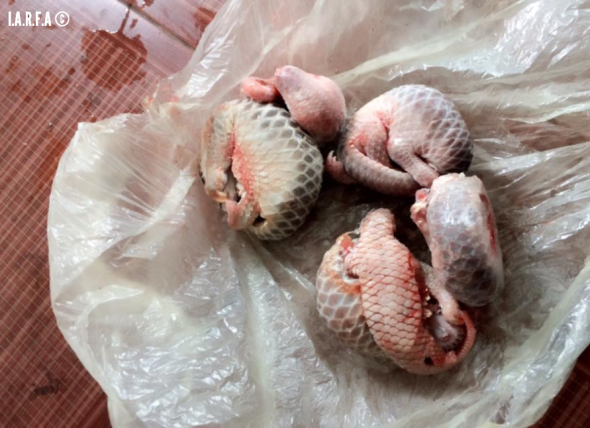
Image: Thailand smuggled endangered pangolins.
Rhinoceros horn is the least likely wildlife trade product that we come-by, simply because of its price, rarity, and the fact so many people around the globe are now putting their foot down relating to this animal part. Unfortunately its not just Rhinoceros horn that we witness being sold illegally online and on the ground. Mr Tu Su whom lives in Ha Tan, Viet Nam was clocked on the 19th August 2016 trading these smuggled pangolin parts online illegally.
Every year there are numerous arrests throughout Asia and convictions relation to pangolin poaching and trafficking, however no sooner is one dealt with - another smuggler and trader rears their ugly head, and can you blame them? All four Asiatic pangolins are now considered extremely rare to the point they’re nearing extinction. Furthermore as the species becomes more rarer - prices increase. These 6 pangolins were trading between $600(USD) and $1000(USD) each. Mr Tu Su has has quite a reputation relating to pangolin smuggling - so for the record below is Mr Tu Su’s face.

Image: Mr Tu Su - Pangolin smuggler and trader.

Image: Mr Tu Su - Pangolin soup.
All 8 species of Asian and African pangolins are ‘listed under Appendix II of CITES’, which means trade is regulated and monitored under CITES, (permits are required from exporting countries for any trade activity). To issue a permit, the exporting country must determine that this activity will have no detriment to the wild population.
As an additional protective measure, the CITES authority passed a (zero export quota for the four Asian species, which bans all commercial trade in these species). However, other purposes (scientific, research, etc.) can still be authorized by permit. For the four African species, there is no zero export quota, which means commercial trade is not prohibited, but permits are still required. Pangolins are also protected in their range states by domestic wildlife laws.
So Mr Tu Su if you’re reading then please note you’ve violated both domestic and international law, we’re holding your details too!
International Animal Rescue Foundation Africa have increased investigations relating to the illicit wildlife trade. Our two main areas of focus is that of the Rhinoceros horn trade and the ivory trade. Since 2015 our investigations surrounding the illegal ivory trade (have located a staggering $6 million(USD) of ivory smuggled from Africa into Thailand, China, Malaysia, Singapore and, Viet Nam.
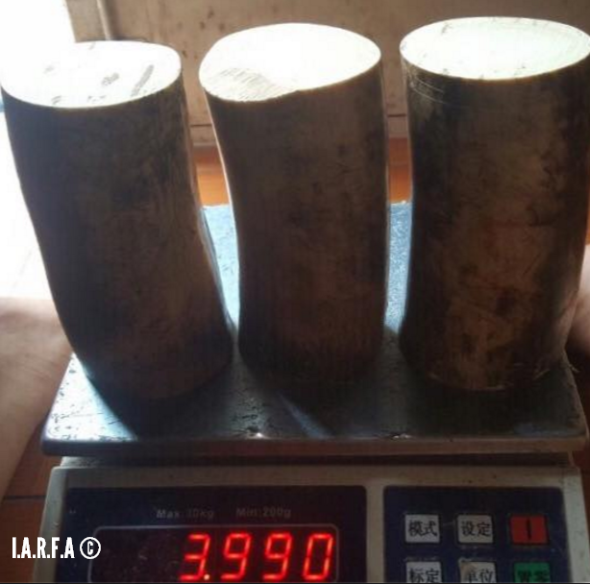
Image: Ivory trafficked from Tanzania onto Viet Nam.
Ivory trader and trafficker Mr Ban Me from Buôn Ma Thuột, Đắc Lắk, Vietnam was observed on the 16th August 2016 trading the ivory above online in one of three secret Vietnamese and Chinese ivory trading online forums. The ivory above is estimated to be around $6,500-$8,000(USD) for the lot.
Mr Ban Me makes no effort to conceal his lucrative online trade neither. When investigating this trader and trafficker we went back through many months of posts within the secret forum, then managed to locate Mr Ban Me who is aged around 35-30 years old. On locating the trafficker/trader it appears from the online evidence that ivory is coming in quick, measured up and weighed, of which either himself or friends then soon after set about to carve the ivory into jewelry.

Image: Ivory measured up and weighed for sale and carving.
Since January 2015 (International Animal Rescue Foundations) Environmental Crimes Officers have underneathed new trading trends relating to the ‘online wildlife trade’. As explained in previous articles most traders nowadays will take delivery of illegal wildlife contraband. From there the wildlife parts are then photographed (as seen in the image below). Traders will either then set up a ‘pseudo Facebook profile’ or already have one in place. The Facebook profile will act as a mobile online shop.
Most traders and traffickers we’re investigating today use this method of online illegal trading. They know by using a throw away or cheap (non-traceable cell phone) that any chance of them being located is slim. Traders are rarely seen selling in bulk on the streets of Viet Nam or over the borders in other Asian countries. Buyers and traders feel safer trading, swapping or trafficking items uploaded to the internet.
Mr Ban Me takes delivery of a large quantity of ivory every month from Africa, most of which has been illegally trafficked into China. Once carved the items are then photographed again to sell online within secret trading rooms to hundreds if not thousands of people. The ivory seen above and below was ‘advertised’ to an audience of over 33,000 individuals.
So as you can see its incredibly difficult for us or any investigate organisation to track in quick time where these products are originating from and ending up. Traders use these rooms online because they know selling to a wider-ranged audience products can shift quickly. Unfortunately for Mr Ban Me we have his contact details, his address, his cell phone numbers, and even know who is selling too and buying from.

Image: Carved ivory on sale from the tusks observed and intercepted online.
Another shocking ‘concern’ is that Mr Ban Me ‘could be purchasing ivory from Thailand elephant traders’. I.A.R.F.A have known for many years now that ivory tusks are being shaved down from Asiatic elephants. A trace of Mr Ban Me’s cell phone images revealed further evidence that showed himself photographing Asian elephants onto his ‘Facebook ivory profile’. Should this be true - it will prove to be further damning evidence that elephants are being exploited within Asia for the ivory trade on a much larger scale than previously documented.

Image: Ban Me photographs Asian elephants onto ivory Facebook profile.
The only image we have of Mr Ban Me is that of his wood workshop in Viet Nam (pictured below). The entire Facebook profile (like many thousands more we have and continue to observe) depicts that of ivory and few rose wood products. The question is though - who’s supplying this young Asian man with ivory? I.A.R.F.A have demanded that Facebook and the F.B.I take action against this illicit trade, and even supplied the Social Media platform with an 11,000+ petition signature however as yet nothing is being done to combat this trade?

Image: Mr Ban Me carving wood in Viet Nam. where ivory is also traded.
Back in December 2015 International Animal Rescue Foundations (Environmental Crime Officers) passed hundreds of pages of evidence onto international law enforcement agencies and Interpol relating to illegal wildlife traders. There have been numerous arrests due to our investigation and, from that investigation other individuals have been looked into resulting in new investigations and arrests too on a global scale. However no sooner is one trader stopped - another one pops their ugly head up from the sand and begins trading.

Image: Mr Ban Me’s ivory Facebook shop profile - ivory tusks, and carved ivory jewelry.
A further trader that ‘openly admitted to I.A.R.F.A Environmental Crimes Officers tried to sell these tusks (pictured below) to an I.A.R.F.A investigator. Going under the name of Mr Thường, from Hanoi Viet Nam, he like Mr Ban Me made no effort whatsoever to conceal his hoard of illicit ivory - most of which was from African elephants. Furthermore he too like Ban Me had created a ‘pseudo Facebook profile to trade illegally elephant ivory’.
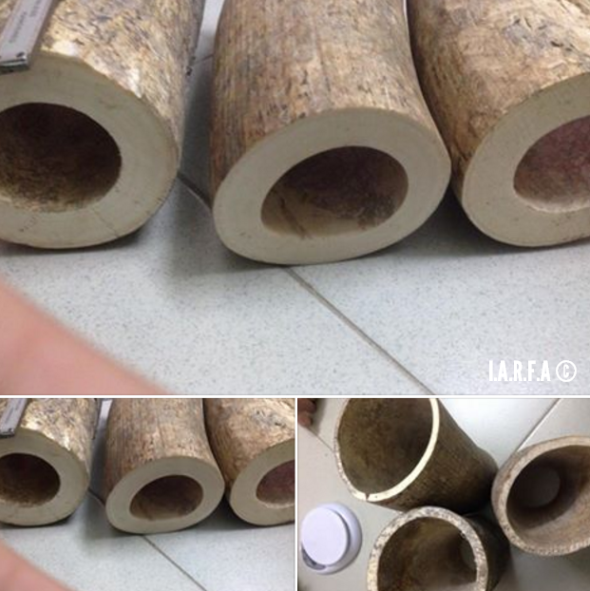
Image: One of many thousands of online Facebook ivory trading profiles.
Viet Nam banned the ‘domestic ivory trade back in 1990’. Furthermore there has been an ‘international ivory trade ban in place since 1989. Unfortunately while these bans have been in place - there are loopholes within some ‘countries domestic trades’ which permits them to trade ‘legally elephant ivory despite international and domestic bans’.
Furthermore ivory can to some extent be sold legally within Viet Nam should the products be antique or purchased before the ivory trade bans. However neither of our investigative officers have located any evidence to prove any of the ivory we’ve located was purchased/obtained legally before any bans were implemented. Damning evidence sent to law enforcement agencies around the globe also proves that ivory is being smuggled from Africa onto Japan and China then back into Viet Nam - Three countries known for their continued ivory trade violations.
While the ivory trade continues to rage out of control there are unfortunately many other illicit and illegal wildlife trades that are increasing within Viet Nam. I.A.R.F.A have noticed a very ‘alarming spike’ of bear parts, mostly moon bears for sale online and on the ground. Environmental Wildlife Crime investigative officers located this species [pictured below] - Ursus thibetanus on the 8th September 2016. The species is identified as the Ursus thibetanus and is listed as [vulnerable] on the (IUCN RED LIST) of threatened and near endangered species.
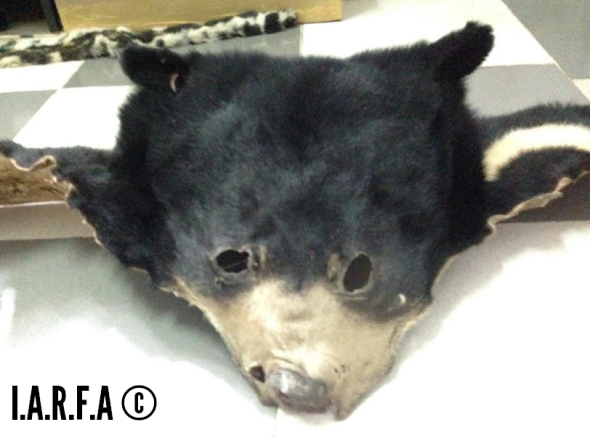
Image: Ursus thibetanus (Moon Bear parts) Viet Nam (2026).
Moon bear pelts, teeth, claws and bear bile are not exactly an uncommon species of animal to be located wihtin Viet Nam’s numerous medicinal markets, although its not common to view the species as it is above on sale within open markets. Bear bile has not decreased in sale on the TCM markets whatsoever in my humble opinion, in fact we (the organisation) hold very recent and damning evidence to prove that bear bile farming practices are sill very much operational. So damning that it does in fact bring many Non Profit Organisations into question with regards to their allegations of practically stopping this trade, when clearly its not being stopped!
Due to many counterfeit animal products on the markets, before any investigation is undertaken - Environmental Scientists will conduct routine examinations of purchased bear bile products to check their authenticity. These examinations are undertaken to store and maintain evidence files, to secure closures of illegal markets or, for further secondary investigations. I.A.R.F.A Wildlife Trade investigative officers located the following bear bile products on the market in Viet Nam.
A kilogram of farmed bear bile might cost $240, while the same amount from a wild bear could cost $15,730. Investigative officers were told the bile seen hereto in the image below was from wild bears, however we highly doubt it due to the lack of Asiatic black bears in the wild. Each bottle below was offered to investigative officers for just over $200(USD). I.A.R.F.A Wildlife Trade investigate officers did purchase three at a price of $600(USD) which is considered cheap. The ‘liquid was tested at the Nong Lam University of which proved to be 100% bear bile.
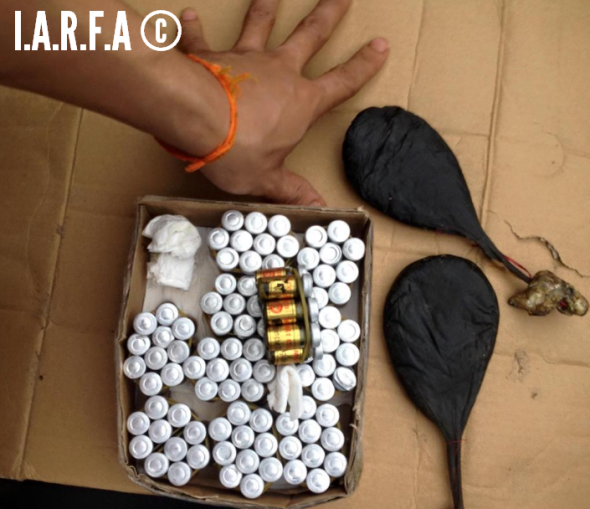
Image: Asiatic Moon bear bile in mass production with gall bladders.
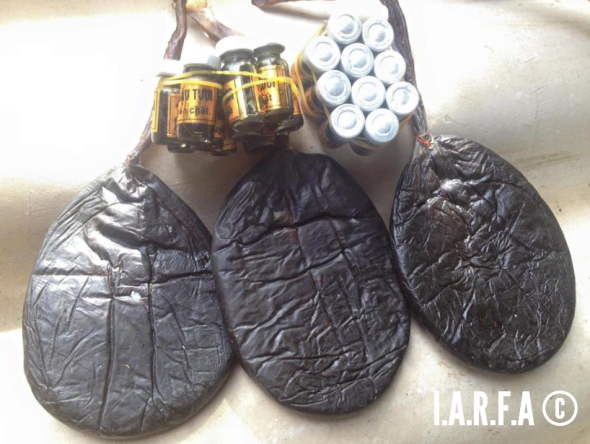
Image: Plastic wrapped gall bladders and bile.
Bear bile does not whatsoever hold any medicinal properties whatsoever, if anything consuming bear bile can actually increase health complaints. The barbaric practice is ‘illegal in China and Viet Nam’, Viet Nam banned bile production back in 1992, sadly the trade still goes on to some extent. Fortunately Viet Nam have stated they’ll be eliminating this horror come 2020, however we’re not holding our breaths just yet.
Mr Nheo who is aged around 21 years of age from the Huong District, living in Hanoi Viet Nam (pictured below) if you’re reading my friend you may want to stop trading pangolins, tiger parts, bear bile, tiger teeth, bear teeth and claws and ivory today. Bear bile hosts no medicinal properties whatsoever so why you’re trading this vile product - which leads to the destruction of bears for we don’t know..

Image: Mr Nheo - Illegal wildlife trader from Hunong District, Viet Nam.
At the last Conference of Parties Summit (CoP15 - Thailand), Viet Nam made a promise to crack down on the countries illegal wildlife trade back in 2013. Although there was no actual deal made, Cites signatories did categorically state that should Viet Nam want any say in the ‘legalized international trade of rhino horn’ the country must clamp down on illegal wildlife trades and markets. I was at the last CoP summit of which Viet Nam agreed it was time to reduce their illegal trade markets - or face the consequences.
The whole purpose of this article and many others is to ‘highlight Viet Nam’s lies; the country hasn’t in my opinion made any progress to reduce their illegal wildlife markets, especially that of (critically endangered species). Yet Viet Nam has been identified as one of the leading countries to be approaching Cites for the ban to be lifted relating to the (international rhino horn trade). I ask myself daily - how is it possible for a country to control any legal trade if they cannot control the illegal trade of wildlife contraband?.
I.A.R.F.A. Environmental Crimes officers working online and on the ground furthermore have noticed a colossal spike in the number of tiger parts and dead tiger carcasses sold within Viet Nam’s illegal wildlife trade markets. The image below depicts a trader that is privately trading tiger teeth. While the quantity of tiger teeth wihtin the image (below) may seem small. I.A.R.F.A Environmental Cyber Crimes officers have been carefully monitoring this trader for well over a year. The vast amount of tiger parts he’s trading is out of this world.
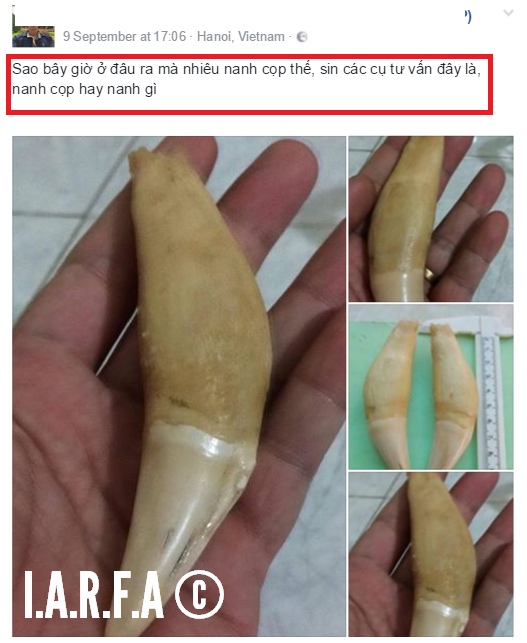
Image: Tiger teeth for sale- Online Secret Wildlife Trading Forum.
I.A.R.F.A have reported various tiger traders in Viet Nam to INTERPOL and local enforcement agencies. However as explained these bloody sickening traders, traffickers and animal killers continue to pop up time again. Most if not all the tigers that we are locating for trade (illegally) were ether captive tigers, smuggled tigers/parts from China and/or Thailand. While other specimens have actually originated from (pathology/veterinary universities inside of Viet Nam).
Three months ago I.A.R.F.A working with overseas enforcement experts concluded - the rare Asiatic leopard we located within a wildlife traders apartment had originated from a veterinary university in Viet Nam. Meanwhile the tiger skins/parts below have originated from Thailand. The question is though from where, who is supplying this amount of tigers and parts to traders within Viet Nam?
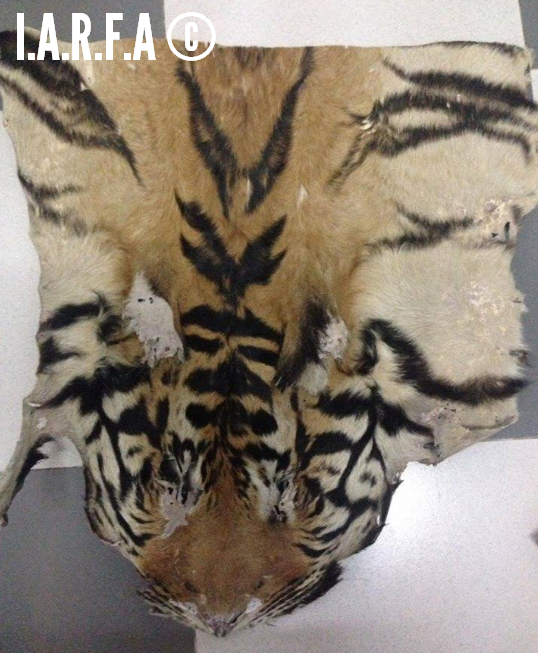
Image: One of many tiger skins offered to I.A.R.F.A investigators September 8th.
International Animal Rescue Foundation Environmental Cyber Crimes Officers was offered this tiger pelt for $1,060(USD). The trader that operates under the name of ‘Mr Coivodich’ also deals in ivory, threatened Rhinoceros hornbills, and bear bile. Furthermore we have been monitoring a very ‘concerning trend relating to tiger skin wallets. Captive bred tigers are slaughtered of which their skins are turned into wallets - a craze that is now becoming incredibly popular throughout Viet Nam. Tigers in Viet Nam are supposed to be bred for conservation purposes only. Clearly though from the images below this is not the case.

Image: Real tiger skin wallets packaged and ready for sale in Hanoi.

Image: Unpacked real tiger skin wallet, priced at $70.00(USD) each.
As explained tigers are supposed to be used for conservation purposes only. However we have located worrying evidence that makes Tiger Temple look more like a walk in the park. A famous Thailand Actor below is seen cuddling a drugged tiger at the Sriracha Tiger Zoo which we believed was a zoo inside of Viet Nam. (See image below). Unfortunately the tiger and this image eventually led back to Thailand, of which this zoo has been named as a horror ground. Would it be wise to assume that tigers are originating from this zoo and ending up within Viet Nam’s wildlife trade? We don’t know. What we do know for sure though is this zoo is now under close scrutiny.

Image: Chen Yunan coaxes drugged tiger in Thailand.

Image: Ranya Rao coaxing drugged tiger in Thailand.
International Animal Rescue Foundation’s Environmental Crimes teams have been working on our new anti wildlife trade project since 2015 being now the ninth major project that we have conducted in the past three years. Most of the evidence we are locating in relation to wildlife trade violations isn’t always within China - a lot of these violations are in fact within Viet Nam.
We are now under four days away from the next Conference of Parties (CoP17) to be held within South Africa, Johannesburg. CoP 17 has been set to be the largest summit held, and as such we may see countries such as Viet Nam asking Cites signatories to agree to a lift of the international trade ban in Rhinoceros horn. Every article that we’ve published in relation to Viet Nam shows the country cannot be trusted with relation to the international rhino horn trade. Every article we’ve published also shows numerous violations of local and international wildlife trade laws.
So the question remains. Is it now time to implement at CoP17 full part of full sanctions against Viet Nam to protect our local and international wildlife? I believe its now time. The evidence in front of you clearly shows Viet Nam’s refusal to act on their illegal wildlife trade markets. So how much more do we have to put up with before everything is eventually gone? Should Cites signatories lift the rhino horn trade ban we’ll keep to our promise. Being all those we know dealing in illegal wildlife products at high end market level will be named, shamed addresses published and that evidence released to the public. Video recordings, audio, images - everything.
The balls now in Cites court - Don’t underestimate us, we may be quiet - but we’ll stay quiet for only a short time before we begin naming and shaming.
Dr Jose C. Depre. PhD. MEnvSc. BSc(Hons) Botany, PhD(NeuroSci) D.V.M.
Environmental, Botanical & Human Scientist.
ENDANGERED SPECIES FRIDAY: PTILINOPUS CORALENSIS | ATOLL FRUIT DOVE.
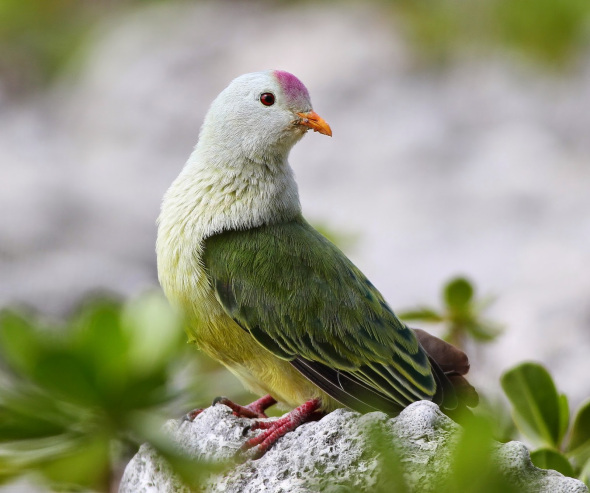
ENDANGERED SPECIES FRIDAY: PTILINOPUS CORALENSIS | ATOLL FRUIT DOVE
This Friday’s Endangered Species Post brushes up on a species of bird that many of you may never have heard of. The atoll fruit dove, that’s listed as (near threatened) is unfortunately nearing extinction within its endemic wild. Image: Atoll Fruit Dove, credits, Steve Smith.
Endemic to French Polynesia, the species was formally identified back in 1848 by Dr Titian Ramsay Peale (November 2, 1799 – March 13, 1885) who was an American artist, naturalist, entomologist, and photographer. He was the sixteenth child and youngest son of noted American naturalist Charles Willson Peale. He is sometimes referred to as Titian Ramsey Peale II to distinguish him from his older brother with the same name who was a favorite of their father and who died at age 18 in 1798.
From 1988 the atoll fruit dove was previously listed as lower risk/least concern, data from that period showed no reasonable justification for the bird to be listed as threatened due to the species being heavily populated throughout the French Polynesia islands. Unfortunately things have drastically changed since the the late 1980’s. French Polynesia is now home to many French and non-French citizens, all of which are gradually threatening the atoll fruit doves habitat - and many other animals too.
Data records prove that from the 1980’s right through to the new millennium the species did live a pretty undisturbed life. However come 2004 the atoll fruit doves habitat and their existence took a turn for the worse. From 2004-2016 the species was (re-listed as near threatened). Populations are still decreasing, and from what we are aware of to date, there has been no official records kept that can prove the current population size which we do find rather strange. French Polynesia isn’t exactly your largest island on the planet.
What does near threatened mean though? Below I’ve extracted a paragraph from the International Union for the Conservation of Nature that will help you understand more about this ‘category‘.
“A taxon is Near Threatened when it has been evaluated against the criteria but does not qualify for Critically Endangered, Endangered or Vulnerable now, but is close to qualifying for or is likely to qualify for a threatened category in the near future“
Scientifically identified as Ptilinopus coralensis, the species is widespread throughout the islands of the Tuamotu Archipelago, French Polynesia. It is likely to occur at low densities throughout its range as its preferred food resources are scarce. In a recent survey it was found to be uncommon on five out of eight islands visited, but others have found it to be abundant on some atolls which have remained free from the ravages of introduced predators.
Scientists haven’t as located any ‘sub-populations’, however have confirmed that there is a ‘continuous decline of mature individuals on the island examined’ however as yet we still don’t know to what extent other than a 30% drop in populations have been recorded.
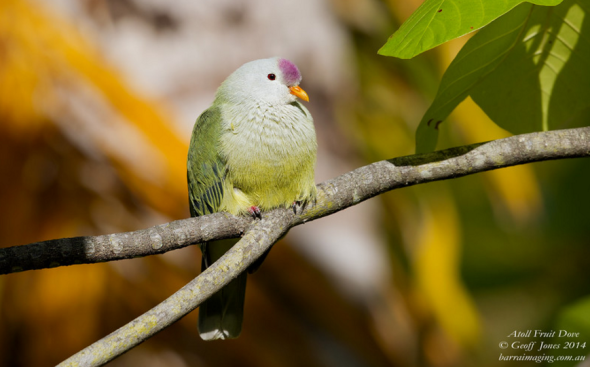
Image: (Google Image Search): Atoll fruit dove (Credits: Geoff Jones 2014)
The atoll fruit dove is the world’s only dove in the tropical Pacific that has adapted exclusively to low coral atolls. It lives in forests and abandoned coconut plantations. It mainly feeds on insects and seeds, usually on the ground. This species also eats the leaves of the “tafano” or “kahaia” (Guettarda speciosa ) trees with odorous flowers.
THREATS
Predation by introduced rats (particularly black rat Rattus rattus) is a threat on a small number of atolls and the species is vulnerable to habitat destruction including the exploitation of coconut plantations. The species is also reported to be rather tame, and is rare on inhabited islands, so hunting may also be a threat.
Although the species is commonly known throughout the French Polynesian islands - there is still to date very little known about the bird. The issue with coconut plantation/exploitation has always been somewhat of a concern for myself and the team. In a sense its no different to be honest than the palm oil trade (however in this case, its coconut farming that is placing the species in danger to some extent!).
I am working with a number of conservationists on the French Polynesia islands that are keeping me updated on this issue overseas, as well as the cruel and barbaric dog and cat meat trade. For now our main priority is to ensure that we undertake a census in relation to the current atoll fruit dove population, examine the threats, and work how to minimize them threats (Etc).. ..Unfortunately though I cannot provide any further up to date information relating to this bird and whether the specie will be extinct soon.
Dr Jose Carlos Depre: PhD. MEnvSc. BSc(Hons) Botany, PhD(NeuroSci) D.V.M
Master of Environmental, Botanical & Human Science.
Chief Environmental Officer and CEO.
CYPRUS: WELCOME TO THE SONGBIRD KILLING FIELDS.
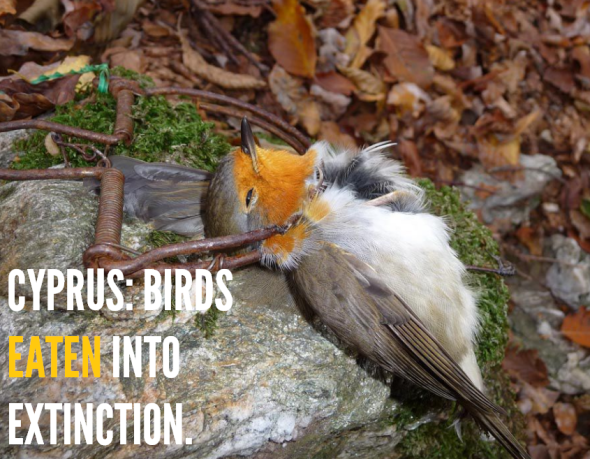
WELCOME TO THE CYPRUS KILLING FIELDS
Just over a week ago, while walking through the local woodland gardens, I noticed a little European robin that just happened to perch next to a fence no more than a few meters in front of me. I was taken aback because, this was the first robin sighting in as many years, today its actually quite rare to spot them, and while I embraced the moment, it dawned on me, why wasn’t I witnessing more of these beautiful birds within the wild?.
Robins normally head south to winter on the Continent, joining other robins passing through in the autumn on their way from Scandinavia and northern continental Europe. Interestingly, it has been shown that many migrating robins are faithful to both their summer and winter territories, which may be many hundreds of kilometers apart. Regardless of where they migrate though I myself and many other conservationist’s are seeing fewer and fewer robins and other song birds.
Every day when I awake I spend a few minutes trying to identify the number of songbirds singing within the wild within the confines of my garden. One can normally identify each individual species of bird by its unique signature melody. As a young boy it was almost difficult to identify more than a handful due to so many songbird species inhabiting the local areas. Today I can identify no more than two or three if that, and in relation to the rare sightings of robins and songbirds - this tells me only one thing - we’re losing our songbirds at an alarming rate!.
Its estimated every year that a staggering TWENTY SEVEN MILLION songbirds are slaughtered on the Mediterranean. Songbirds are unfortunately ending up on the plates of many Cypriots - to the tune of some 1.3 million, of which this number is increasing every year. Cyprus like every country hosts a wide range of traditional and culinary delights. However this culinary tradition must come to an abrupt end - very soon across the entire Mediterranean (not just Cyprus), failing this mass songbird extinctions will occur.

Image: Poached robin, (inset) ambelopoulia song bird delicacy.
Unfortunately one of them so called ‘traditional culinary delights’ is that of boiled songbirds. And please don’t for one minute think I’m singling out Cyprus here. My own country hosts a number of nauseating traditional foods that sees ducks, geese even swans butchered to provide Foie Gras and, songbirds too. Germany sells a number of robin dishes, while Malta is an even bigger offender killing hundreds of thousands of birds every year just to provide a so called “traditional food” for the locals and foreigners. Songbirds are vanishing from the Mediterranean, and the rate at which they’re being eaten is very likely to push many species into extinction in the next decade.
Cyprus has a plethora of customs due to its long history and tradition and numerous distinctive dishes for visitors to taste. The best place to do this is in one of the many traditional tavernas dotted around the island’s attractive villages, where one could order a selection of Cyprus dishes such as koupepia, souvla, kolokasi, pourgouri, seftalies and makaronia tou fournou to name just a few. For the ultimate gastronomic experience in Cyprus, the best way to try all of these and more in one sitting is as ‘mezedes’, a selection of more than 20 vegetable and meat dishes – make sure you are hungry as food will be plentiful.
However while all of these dishes may sound, look and even taste nice, a large minority of individuals on the island of Cyprus (not all), indulge in the local and traditional delicacy of boiled or grilled songbirds. Back in 1974 the government of Cyprus was lobbied and pressured to ban songbird trapping, and poaching. Today its currently still illegal to trap songbirds (as seen in the image above). While these laws prohibit anyone from illegally trapping, killing and serving up ambelopoulia - the law is very rarely enforced, which does concern us dearly. Furthermore what’s the point in having laws in place (since the 1970’s) if you’re not going to follow through with them?
AMBELOPOULIA
Mention ambelopoulia to a songbird - and it sends shivers through them, (well not literally); ambelopoulia is though the main Cyprus culinary delight - of which songbirds are pickled, roasted, grilled or boiled served with a number of vegetables or sweet fruit sauces. The traditional food normally involves boiling songbirds. The two common species of birds eaten are that of blackcaps and European robins - which is probably why I’m seeing fewer songbirds every year.
As a result almost 2,418,000 birds across the whole of Cyprus were estimated to have been killed during 2010. According to a BirdLife Cyprus report released in 2014, over 1.5 million migrating songbirds are killed annually, and the number is increasing each year. In 2015 it was estimated that over 2 million birds were killed including over 800,000 on the British Territories. Now there are new reports issued this year by various bird groups that confirm we are losing a staggering 27 million songbirds every year on the Mediterranean - many of which are killed for human delicacies.
Songbirds are trapped, killed, trafficked and consumed within many European countries. Spain, Germany, Italy, France, Belgium, Greece, Romania, Serbia, Slovenia, Russia, Malta, and of course Cyprus - all of which is mostly illegal. What makes matters even worse (in relation to Cyprus) is that a large number of songbirds are actually killed on the local British military bases on the island, so why are the Brits allowing this dare I ask?. Birdlife Cyprus stated in a report this year: “Over 800,000 birds were trapped and killed illegally on a British military base in Cyprus last autumn, according to the latest research by the RSPB and BirdLife Cyprus”.
Organised crime gangs are running this illegal practice on an ‘industrial scale’, which is estimated by the Cypriot authorities to earn criminals on the island 15 million Euros every year. Survey data from BirdLife Cyprus and other organisations have recorded over 150 species of bird which have become trapped in mist nets or on lime-sticks (pictured below). More than half of these species are of conservation concern. On a positive note, the results from 2015 show that there’s been a stop to the ‘annual increases’ of the last five years in numbers of birds killed on British Territory, thanks to various measures taken to tackle the problem by the Base authorities. The numbers however remain around record-breaking levels, with levels of illegal killing still far worse on British Territory than in the Republic of Cyprus.
The trappers defend their activity by citing the practice as traditional Cypriot food gathering and claiming that this has been an important source of protein for the natives for many thousands of years, even though the practice has been illegal since 1974. BirdLife Cyprus has identified restaurants as the main culprits as they provide the financial incentives. The enthusiasm Cypriots and many other visitors to the island have for this delicacy despite its illegality has resulted in the development of a very profitable industry.
Poaching for ambelopoulia has been on the rise in recent years, involving by 2011 a “mafia-like operation” that include poachers, dealers, exporters, and restaurant operators that participate in the illegal business estimated to be worth about 5 million euro at that time (2011). The birds reportedly sell for five euros each and it is estimated by Cypriot authorities to have earned criminals on the island 15 million euro in 2015.
LIME STICKS
Cypriot poachers illegally poach songbirds using a number of methods. One of them (seen pictured below) are lime sticks. The use of lime sticks is ‘strictly illegal’, however as explained above, despite laws in place on the island local authorities still turn a blind eye.
Lime sticks are a simple but particularly cruel and indiscriminate method of trapping birds. ‘Twigs’ are covered with a sticky ‘lime’ or ‘glue’ (in Cyprus trappers traditionally used a concentrate made from boiled Syrian plums) and are placed wherever birds can be tempted to perch. This could be in natural vegetation like bushes or trees, or sometimes lime sticks are pushed into the ends of bamboo poles. And as you guessed - once the bird lands on the lime stick they are stuck fast.
The more the bird struggles, the more it becomes entangled within the sticky like natural/unnatural substance. Songbirds die a horrific death, struggling for hours before being crushed to death by poachers, or dying of extreme exhaustion and stress. Just in one area (such as local gardens alone), its estimated that ‘hundreds of lime sticks are set up to catch as many birds as possible’. More than TWO MILLION songbirds are illegally poached using this method of trapping - which is cruel, painful, and totally barbaric.
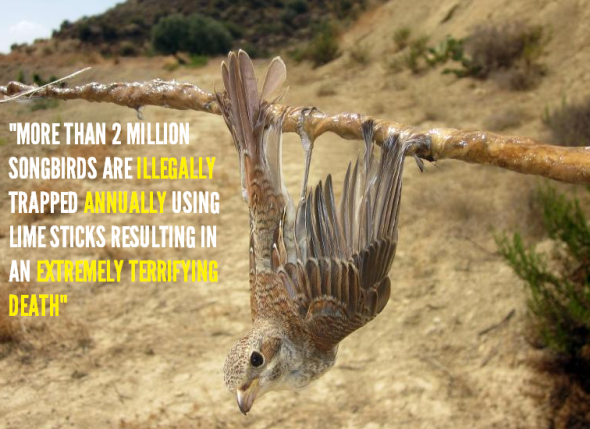
Image: Lanius collurio (Red Backed Shrike) trapped using a lime stick.
In Cyprus alone its “estimated that some one million songbirds are caught using this method of illegal trapping. Most of the sticks are set up within residents gardens - which makes policing even more difficult. One must also think - how is it even possible for every single home within Cyprus to be monitored by the local authorities?.
Lime sticks are so effective because when a bird lands its legs bend causing two flexor tendons to tighten which ‘lock’ the toes around a perch. This involuntary reflex (designed to stop perched birds falling while they sleep) means that the bird in effect presses down hard into the ‘lime’ as soon as it makes contact with it. Birds become stuck immediately. As they flutter to free themselves their wings, head, and even beak will often become stuck too.
“TRAPPERS RIP THE BIRDS FROM THE LIME STICK AND CRUSH THEM TO DEATH”
Birds caught on lime sticks are unable to get free and hang helplessly – often for hours – until the trapper comes and literally rips them off the stick and crushes them to death.
Article 9 of the European Birds Directive (2009/147/EC, formerly 79/409/EEC), states that trapping methods that are non-selective or are used for large-scale capture or killing of birds are prohibited in European Member States. This includes lime sticks, and their manufacture, sale, ownership, and use is therefore illegal across the EU. Unfortunately while this horrific method of trapping may indeed be illegal - poachers are still getting away with murder.
MIST NETS
I’ve spent a number of years living on the small island of Malta (on and off) and, a number of years trying to destroy these bloody nets with the help of many local and overseas activists. Mist nets are just as cruel and barbaric as lime sticks, although I must state that birds are caught instantly, and killed there and then - nevertheless their deaths are still horrific.
Mist nets are often use by poachers on the island of Cyprus to catch a larger number of birds, meanwhile these very same poachers will also have lime sticks deployed within key areas. So it kind if gives you a little more insight into just how greedy poachers and buyers have become. Furthermore the rate at which we’re losing songbirds - and the levels of poaching increasing, what’s next when extinction finally does occur. Mist nets are also used within Spain, France, Romania, and Germany (among many other EU countries).
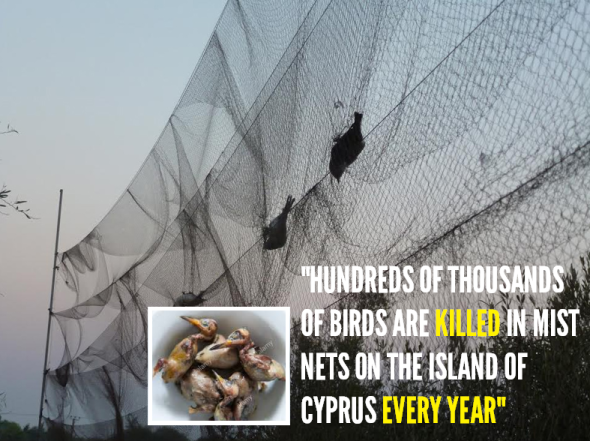
Image: Mist nest. Inset is the local delicacy of Cyprus.
Its estimated (just in Cyprus alone), hundreds of thousands of birds are caught and brutally slaughtered within mist nets every year, and with over a million more using lime sticks - and with laws rarely enforced on the island of Cyprus, will we be seeing a colossal extinction soon of migrating songbirds? I hate to say this, but unless laws are enforced and action is taken against poachers on a larger scale - extinctions will occur.
International Animal Rescue Foundation France has thus far located a total of 139 restaurants on the island of Cyprus, of which we have uncovered out of them 139 some 24 which are selling illegally ambelopoulia. I.A.R.F.F believe that the number of restaurants illegally trading ambelopoulia is much greater than 24. Furthermore due to the dish being so popular and craved after, its highly likely that the ‘majority’ of restaurants are trading ambelopoulia. International Animal Rescue Foundation France are calling on all tourists to please BOYCOTT all Cyprus restaurants that are trading openly this vile and cruel so called delicacy.
The birds sell for approximately CY2.00. One tourist stated: “Consumers are encouraged to swallow the bird whole”. On a plate you’re normally served in between four to five songbirds, and a number of other dishes too. If you are a tourist please, please do not indulge in this delicacy, and report the restaurant immediately to the local police. Another tourist that visited the area of Laxia, stated: “Laxia is somewhat of a favorite with the police, mayor and local mafia. So if there’s anything illegal going on you’ll probably find it there”. From what we are aware locals don’t encourage you to swallow the dead boiled bird[s] whole, however it wouldn’t be somewhat of a shock if this was factual.
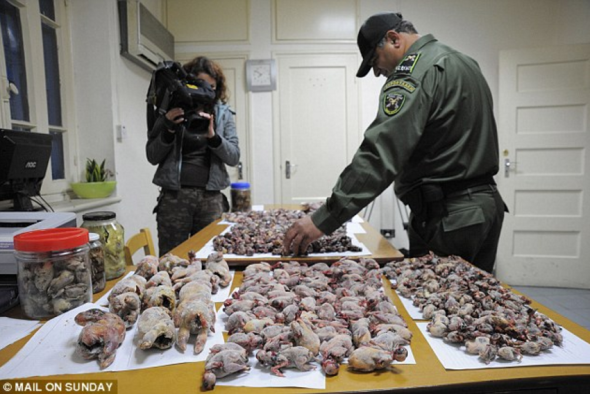
Image: Poached songbirds confiscated from poachers on the UK armed forces base.
“WHY ARE SONG BIRDS IMPORTANT?”
Songbirds are an incredibly important species of bird consisting of over 159 separate species that are endemic mostly to Europe, and as far away as Asia, America, Canada and Africa. While eating them may seem “important or traditional”, scientifically speaking you’re actually harming the environment, and removing yet another food chain link that many other species of animals depend on.
For management purposes, songbirds are part of a group called “land birds,” species that rely mainly on terrestrial habitats and some vegetated wetlands. Songbirds eat a wide variety of foods, including insects, seeds, berries, nectar, and fruit. If we lose our songbirds there will be a dramatic increase of insects, and an alarming decrease in foods that we humans also require.
Furthermore we and other animals need songbirds to continue the spread of plant, fruit and vegetable seeds to ensure that we and animals don’t go hungry. The same applies to fruit trees and bushes too. Many songbirds pollinate fruit trees and bushes - of which them plants and trees provides humans and animals fruits and berries. Finally as explained above - many songbirds are also a vital bird crop pollinator - should extinction occur, then we’ve lost a massive pollinating species that we humans and animals rely on. Are you ready to pollinate crops by hand, or prepared to pay higher prices for fruit and vegetables?
Reptiles, snakes, lizards, and even marine species such as sharks eat songbirds which are part of their diet. No songbirds means a drastic decline of food prey for reptiles, snakes, lizards, marine and amphibious species. So while you may not think songbirds are important - they truly are. Because the trapping methods are non-selective, 150+ species are known to have been caught in the traps. More than a third (58 species) of these are species of conservation concern, including the lesser kestrel, which is vulnerable to global extinction.
Extinction here is really not an option and, we must do more to preserve and secure our songbirds habitat and them too. There are many links and a handful of videos within this article, plus many alarming facts. Please share, and please help us and many other groups defend Mother Natures songbirds. If you see a trap or mist net, please report it. If you can destroy them traps without harm coming to yourself, then please do so. You can even call on us and other groups to destroy these illegal traps too.
“EXTINCTION IS NOT AN OPTION”
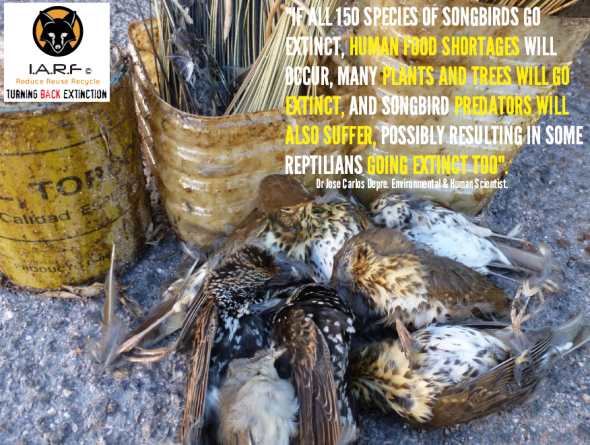
Thank you for reading.
Dr Jose Carlos Depre.
Environmental, Botanical & Human Scientist
PhD. MEnvSc. BSc(Hons) Botany, PhD(NeuroSci) D.V.M.
Endangered Species Monday | Potorous gilbertii - Back From The Brink Of Extinction.
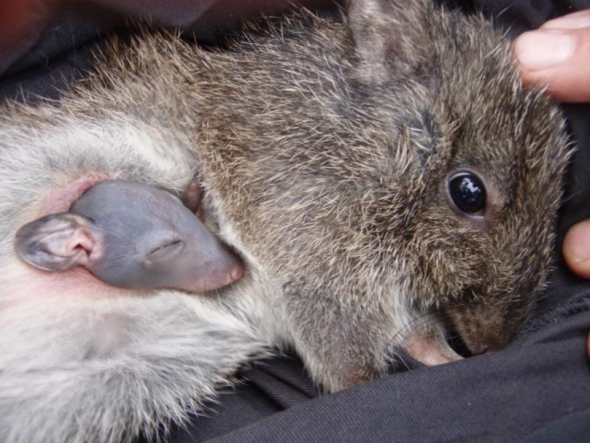
Endangered Species Monday | Potorous gilbertii
This Monday’s (ESP) post, I’ve decided to document a little more on Australia’s wildlife. This Monday I have dedicated this post to one of Australia’s most endangered marsupials. Commonly known as the Gilbert’s Potoroo. (Image Credit Parks and Wildlife Australia).
Identified as the worlds ‘rarest marsupial’, the species is scientifically known as the Potorous gilbertii. Listed as (critically endangered) the species was primarily identified back in 1841 by Dr John Gould FRS - 14 September 1804 – 3 February 1881) who was a British ornithologist and bird artist. He published a number of monographs on birds, illustrated by plates that he produced with the assistance of his wife, Elizabeth Gould, and several other artists including Edward Lear, Henry Constantine Richter, Joseph Wolf and William Matthew Hart.
Dr Gould has been considered the father of bird study in Australia and the Gould League in Australia is named after him. His identification of the birds now nicknamed “Darwin’s finches” played a role in the inception of Darwin’s theory of evolution by natural selection. Gould’s work is referenced in Charles Darwin’s book, On the Origin of Species.
Life hasn’t been at all easy for the P. gilbertii. It was only back in 2012 that conservation and environmental scientists (rediscovered) the species of which it was believed the marsupial had gone completely extinct within the wild. Endemic to Australia there is very little known in relation to when threats came about, increased and decreased. However I can state now; as small as populations are known - P. gilbertii’s populations are ‘currently stable within the wild’.
While though populations are stable, there are only thirty to forty actually known to be living within their endemic wild, so there is still a large amount of concern for the worlds most endangered marsupial. Back in early 1980’s the species had been listed as (completely extinct within the wild after studies from the 1800’s turned up nothing). Fortunately though environmental scientists went on the prowl and were not under any circumstances ready to write this species off whatsoever. They were technically looking for an animal that hadn’t been seen since the 1880’s-1990’s. Their work though eventually paid off.
“THEN CAME A BREAK THROUGH IN 1994”
Environmental scientists come 1992-1993 were ready to write the species off, call off all explorations and projects that were aimed at hopefully rediscovering the species. Fortunately though the Australian Parks and Wildlife Service persisted - and come 1994 a spotting was recorded. After so many years believing the Gilbert’s Potoroo had gone extinct, scientists discovered an extremely small population - to the joy of many. Finally there was hope, and today the species remains under full governmental protection.
Native to South-western and Western Australia the remaining populations was taken by three collectors between 1840 and 1879 in the vicinity of King George’s Sound (Albany), but exact locations are unknown. Skeletal material is common in cave deposits between Cape Leeuwin and Cape Naturaliste. Sub-fossil skeletal specimens have been located in coastal sand dunes between these localities. It is currently restricted to Mt. Gardner promontory in Two Peoples Bay Nature Reserve.
The entire population (consisting of 30-40 mature individuals) as explained above remains inhabits the Two Peoples Bay Nature Reserve of which they enjoy protection from the local parks wildlife board. While populations are identified as extremely small, mother will give birth to either 1-2 babies every year, normally its 2 babies. Like kangaroos the species has the ability to keep a second embryo in a state of diapause while the first embryo is growing. If the first baby does not go to term, a second baby starts growing right away.
Check out the Gilbert’s Potoroo Action Group by clicking this link
Diapause is considered a rare phenomena - especially in kangaroos, although its been witnessed quite a lot over the past few years by European, British and Australian Zoologists. The last diapause event (that I’m aware of) was witnessed at the Taronga Zoological Gardens in Australia. You can read the story >here.< The gestation period for Gilbert’s potoroo is unknown, but is estimated to be similar to the long-nosed potoroo at 38 days.
Since so few are alive today, much of the reproductive cycle for Gilbert’s potoroo remains unknown. However, the main breeding period is thought to be November–December with similar breeding patterns to those of the long-nosed potoroo. Scientists have tried to breed them in captivity, but recent attempts have been unsuccessful, citing diet, incompatibility, and age as possible factors that influenced the lack of reproduction. Reproduction in the wild is thought to be progressing successfully as many females found in the wild are with young.
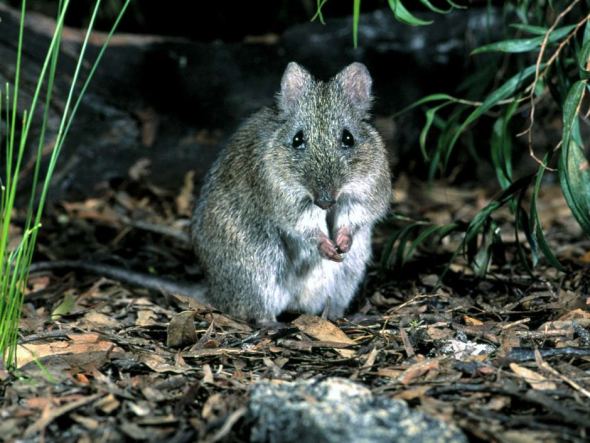
Image: Gilbert’s Potoroo. Photographer Mr Dick Walker.
In 2001, the Gilbert’s Potoroo Action Group was formed to help in the education and public awareness of the potoroo. The group also helps with raising funds for the research and captive-breeding programs for Gilbert’s potoroo. In efforts to protect the remaining population, three Gilbert’s potoroos (one male and two females) were moved to Bald Island in August 2005, where they are free from predation. Since that time, an additional four potoroos have been sent to establish a breeding colony.
THREATS
Fire is the critical threat (present and future) to this species as the Mt. Gardner population is in an area of long unburnt and extremely fire prone vegetation, and a single fire event could potentially wipe out the species (except for the few individuals in captivity and on Bald Island). This species is in the prey size range of both feral cats and foxes, and both are known to exist in the Two Peoples Bay area, thus this species is likely threatened by these predators.
Maxwell et al. (1996) states that the reasons for the decline of the species are unknown. Predation by foxes has probably been significant. Changed fire regimes may have altered habitat and/or exacerbated fox and cat predation by destroying dense cover. Gilbert’s notes record it as “the constant companion” of Quokkas, Setonix brachyurus
Unlike Gilbert’s Potoroo, the Quokka, although declining, persists over much of its pre-settlement range. The difference has not been explained. Maxwell et al. (1996) and Courtenay and Friend (2004), suggest that dieback disease caused by Phytophthora cinnamomi threatens persisting populations by eliminating plant symbionts of hypogeal, mycorrhizal fungi which are the principal food of Gilbert’s Potoroos. Altering vegetation structure and eliminating plants that provide food are direct threats to this species.
For now and based on various accounts, research and up to data documentaries. The species is still in danger. As explained above a single large and sporadic fire within the species habitat - could kill off the entire identified populations, which would be a catastrophe. While there is minimal threat from predators such as foxes and feral cats - this could change. So the need for persistent monitoring is a must. Finally we have disease, with populations being so small at around 30-40, any single disease could like fires wipe the entire species out within a single week.
Within the article above I’ve included various links for your immediate attention and information, as well as a link to the main working group that is helping (and doing all they can) to preserve the species. Furthermore I’ve included a donation link for you to donate to the Gilbert’s Potoroo Action Group. While I’m not entirely sure whether you can volunteer, there is a link on the main website below (highlighted: Volunteer Today). Just click the link, follow the instructions and, I’m confident someone will get back to you as soon as possible.
Volunteer Today
Thank you for reading, please don’t forget after reading to share this article, and hit the like button too.
Dr Jose Carlos Depre Depre PhD. MEnvSc. BSc(Hons) Botany, PhD(NeuroSci) D.V.M.
Environmental & Human Science
Endangered Species Monday | Brachylophus fasciatus.
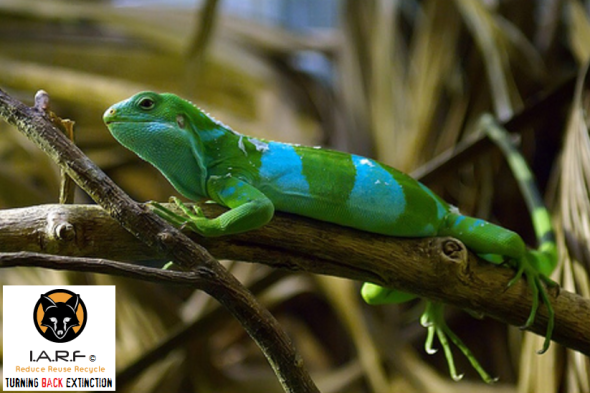
Endangered Species Monday | Brachylophus fasciatus
This Monday’s (ESP) Endangered Species Watch Post report I document on a rather “undocumented species” of iguana identified back in the 1800’s. (Photographer unknown)
Identified back the 1800’s, and listed as [endangered] the species was originally identified by French Dr Alexandre Brongniart (5 February 1770 – 7 October 1847) who was a French chemist, mineralogist, and zoologist, who collaborated with Georges Cuvier on a study of the geology of the region around Paris.
Dr Alexandre Brongniart was born in Paris, the son of the architect Alexandre-Théodore Brongniart and father of the botanist Adolphe-Théodore Brongniart. He was an instructor at the École de Mines (Mining School) in Paris and appointed in 1800 by Napoleon’s minister of the interior Lucien Bonaparte director of the revitalized porcelain manufactory at Sèvres, holding this role until death.
The young man took to the position a combination of his training as a scientist— especially as a mining engineer relevant to the chemistry of ceramics— his managerial talents and financial acumen and his cultivated understanding of neoclassical esthetic. He remained in charge of Sèvres, through regime changes, for 47 years.
Commonly known as the Fiji Banded Iguana, Lau Banded Iguana, South Pacific Banded Iguana, or Tongan Banded Iguana the species is unfortunately endangered and nearing extinction within the wild. A reptilian, and member of the iguana family the species has been placed within the order of (Squamata).
Within the past TWO DECADES the species has undergone a decline of some 50% throughout its range. Furthermore species declines are still ongoing with no apparent let up neither, (threats have been noted as significantly severe and widespread).
Without conservation intervention, the degradation observed during the last 20 years is predicted to cause further declines over the next 20 years that approaches 80% and potentially will be found to be even higher with further population analysis. Basically unless conservation efforts are improved or continue then we will lose the species very quickly.
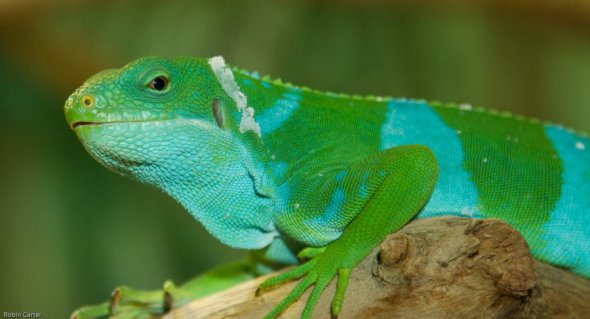
Image: Fiji Banded Iguana (Credits: Robin Carter)
Now to some humans this may not seem much to worry about. However let me ask you this. Have you experienced a rather large number of flies bothering you, mosquitoes, insects, and general bugs wreaking havoc with your everyday life? If the answer is “yes”, then maybe you need to be paying attention to my articles. Reptiles loves flies, and without reptiles there will be more flies.
Endemic to Fiji, the species has recently been introduced to Tonga. Among all the islands surveyed for the presence of Lau Banded Iguana, only on the two Aiwa Islands were enough lizards found to estimate a population size, this was estimated to number less than 8,000. That population size is concerning (especially when we take into consideration life span, gestation, and threats). 8,000 can soon turn into 1000 in under five years.
Although there is no official “population size estimates”, its believed from census reports (which I myself do question), within the past 35-40 years the species has undergone (as explained above) a decline of 50%. Discussions with island residents indicate that on most islands the iguanas are now more rare than they had been in the recent past.
Most islands in the region are now inhabited and iguanas were generally found in degraded forests or remnant forest patches, but not in proximity to villages or gardens. Surprisingly, among the uninhabited islands surveyed only one was found to have iguanas present, but this is likely due to the abundance of cats present on the iguana-free islands. It is known that local residents intentionally translocate kittens to these uninhabited islands for rat control.
In summary, a total of 52 islands in the Lau Group and Yasayasa Islands were visited between 2007 and 2011 and iguanas were detected or reported from only 11 islands, with an additional report from one island that was not visited. The sheer fact we only have on ELEVEN ISLANDS instead of FIFTY TWO Fiji Banded Iguanas, just goes to show we have serious problems here that need addressing before its to late.
Iguanas were abundant on only three islands, the two neighbouring Aiwa Islands and Vuaqava, all of which are uninhabited. Goats have recently populated all three of these islands and Vuaqava has a seemingly large cat population (which could be a threat). Most of these 53 islands should have had resident iguana populations. For example, two islands with historic populations, Moce and Oneata, were described by the Whitney Expedition and have since been extirpated. Given these results, it appears that iguanas could be remaining on about 20% of the islands in the region and are abundant on only 5%.
“SO WHAT ARE THE THREATS?”
The current band at which the Fiji Banded Iguana sits in (in regards to known population levels) is 8,000 120,000 mature individuals. Now that doesn’t mean we have 8,000 or 120,000 mature individuals. The current band basically means what we have “assumed the population” based on very sketchy and rough census estimates. What we do know, is that from the last census conducted only 8,000 were eye balled (meaning that 8,000 were physically witnessed). Further census counts are underway.
Lau Banded Iguanas are sometimes locally kept as pets, and this was observed on three different islands during surveys in 2011. Historically, these iguanas would have been a local food source, similar to the larger extinct species (Lapitaiguana and B. gibbonsi) in the region, but there are no recent records of human consumption. The black market trade in Brachylophus does not include this species and is unlikely to be a threat in the future as its remaining localities are very remote.
Black Rats (Rattus rattus) and feral cats (Felis catus) are the main mammalian predators threatening the persistence of iguanas and are capable of causing local extinctions in a relatively short time period. Fortunately, mongoose has not been introduced to the Lau Group yet, and maintaining it free of them is an important biosecurity issue. On a few islands, free-roaming domestic pigs (Sus scrofa) were observed to cause major disturbance in small forest patches, turning large areas to bare mud that is no longer suitable for iguana nesting.
Even in the absence of goat herding, forest burning is widespread and is increasingly one of the biggest threats to iguana habitat and their persistence. Continued deforestation on the small islands where Lau Banded Iguanas remain is predicted to cause additional local extinctions over the next 40 years. In particular, on the large islands of Lakeba and Vanua Balavu where iguanas should have been numerous, there has been significant forest loss through deforestation, burning, and fragmentation.
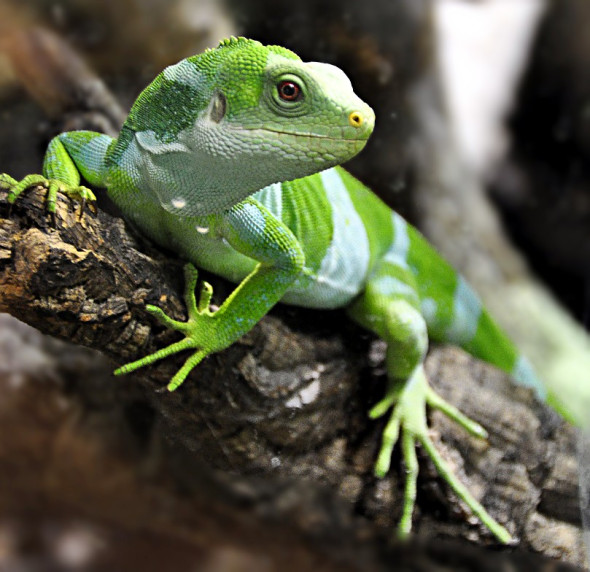
Image: Fiji Banded Iguana (Photographer unknown).
Additional threats to the native forests include further development of urban and village areas, plantation agriculture, and logging. In particular, harvesting Vesi Tree (Intsia bijuga) for use in traditional carving on several islands (for example, Kabara) has significantly reduced the native forest. Forest conversion to Caribbean Pine plantations is also significant, especially on Lakeba.
Proposed development of tourism resorts, on the smaller islands in particular, has significant impacts on these habitats, possibly leading to losses of entire iguana populations as has been observed elsewhere in Fiji. Finally, proposed new cruise ship routes to the remote Lau islands will require construction of new infrastructure and is likely to be a source of invasive species from Viti Levu unless strict biosecurity measures are enforced.
The impact of the recent introduction and spread of the invasive alien Common Green Iguana (Iguana iguana) in Fiji are not yet known for this species but have been shown to have significant detrimental effects everywhere they have been introduced. Eradication for this invasive now appears unlikely, and it is possible the Green Iguana will continue to spread to other well-forested islands despite eradication efforts. Green Iguanas are vastly more fecund and aggressive than native iguanas and may have significant effects on remnant small island populations.
At minimum, this introduction has caused considerable confusion in the local education programmes aimed at protection of Banded Iguanas versus eradication of the Green Iguanas, since juveniles of the latter appear superficially similar. The northern Lau Islands are very close to Qamea where the Green Iguana was first introduced and are at high risk of invasion.
Irruptions of invasive alien Yellow Crazy Ants (Anoplolepis gracilipes) are known to occur on many of the southern Lau islands. Even though these ants were introduced to Fiji over 100 years ago, it is not understood what causes populations to periodically irrupt in huge numbers on some islands. When Crazy Ants irrupt, the entire ground surface, shrubs, and trees are entirely covered with ants and it has been observed that native skink and gecko abundance drops greatly during this time.
The impact of aggressive ant irruptions on iguana reproduction and recruitment is not known, but is likely to suffer similarly to other lizards. Lau Banded Iguanas are sometimes locally kept as pets, and this was observed on three different islands during surveys in 2011 (as explained above).
Historically, these iguanas would have been a local food source, similar to the larger extinct species (Lapitaiguana and B. gibbonsi) in the region, but there are no recent records of human consumption. The black market trade in Brachylophus does not include this species and is unlikely to be a threat in the future as its remaining localities are very remote.
Listed as endangered, the current future is not as yet known. However what we do know is that the Fiji Banded Iguana does not inhabit the ground it once did. Threats are wide, and the species has undergone a large population decline.
Thank you for reading.
Dr Jose C. Depre PhD. MEnvSc. BSc(Hons) Botany, PhD(NeuroSci) D.V.M.
Environmental, Botanical and Human Science.
Endangered Species Friday: Macrotis lagotis | Bandicoot.
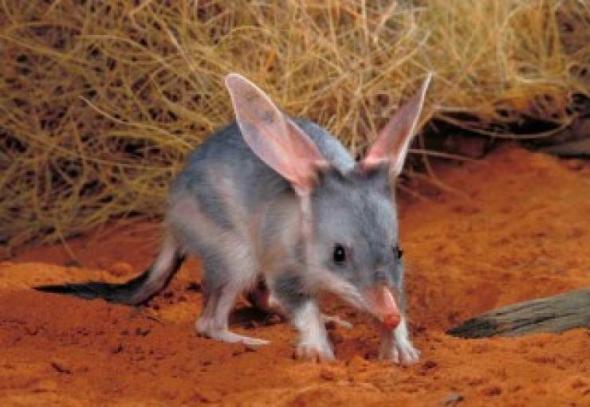
Endangered Species Friday | Macrotis lagotis
This Fridays (ESP) [Endangered Species Post] I touch up on the Macrotis lagotis, commonly known as the Rabbit-eared Bandicoot identified back in 1837 By Dr Reid. (Image credit unknown, explorer unknown).
The Rabbit Eared Bandicoot is the fifth Australian marsupial that I’ve documented on since establishing the (Endangered Species watch Post), covering now over 403 species of animals (worldwide) in exactly 5 years. From 1965 very little was actually known about the Rabbit Eared Bandicoot, despite the fact it was formally identified way back in the 1800’s.
Unfortunately when scientists eventually managed to re-locate the species, they found the animal was in fact nearing extinction within its endemic wild. Listed then as (ENDANGERED) the species almost went extinct from the 1980’s - 1900’s. Fortunately environmental scientists worked hard to preserve this rather unusual animal. From 1990 the species was still listed as (endangered - and nearing complete extinction within the Australian wild).
Fortunately from 1994-1996 species recovery programs increased populations within the wild. Come 1996 the species was re-listed as (vulnerable). Commonly known as the ‘bilby’, M. lagotis once inhabited some 70% of Australia. Wild populations are now restricted predominantly to the Tanami Desert (Northern Territory), the Gibson and the Great Sandy Deserts (Western Australia), and one outlying population between Boulia and Birdsville (south-west Queensland). The bilby has gone extinct from portions of southern Queensland within the last few decades.
However despite numerous conservation actions that have been aiding and increasing bilby populations, they are now on the decrease; slowly, but surely, for how long though is another story. Endemic to Australia (Northern Territory, Queensland, and Western Australia) its believed there are no fewer than 500 individuals on Thistle Island, 500 in Arid Recovery, 100 in Venus Bay, 200 in Peron, 40 in Scotia, 200-500 in Queensland.
There are fewer than 1,000 individuals in the Northern Territory and 5,000-10,000 in non-reintroduced Western Australia. The global population might be under 10,000 individuals. The species is wide-ranging and patchily distributed. The population estimates of bilbies in the Northern Territory and Western Australia are very approximate, as there are no published numbers in peer-reviewed journals. It is known from aerial surveys that bilby signs (diggings) in the areas where bilbies are persistent occur less than 15 to 20 km apart.
“TEN THOUSAND INDIVIDUALS REMAINING”
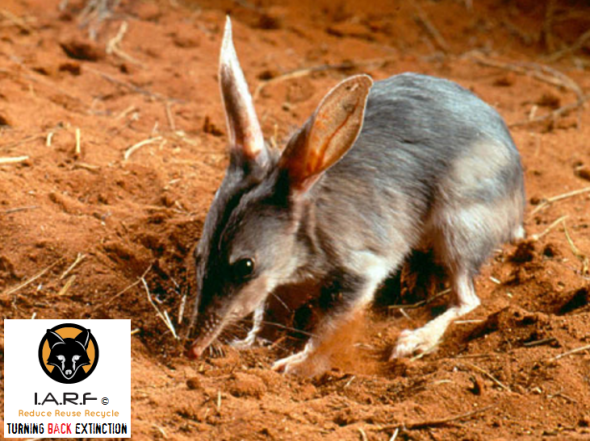
Image: Bilby, Australia. Photographer unknown.
Bilby populations are not known to be seriously fragmented, and from what I am aware the species is protected under CITES APPENDIX I (Convention on International Trade in Endangered Species of wild Fauna and Flora).
“WHAT’S WITH THE LARGE EARS?”
You’ll find that many small and even large animals that live within extremely arid and hot countries, and are active during the daytime will host large fan like ears. Without these large cooling like rabbit ears many species of animals wouldn’t be able to radiate heat away from its most important organs - being the brain. Smaller ears would most certainly result in the mammal dying from massive heat stroke, and dehydration. However due to the lack of research on the bilby, we still don’t know for sure if these massive ears do indeed help keep the species cool.
Bilby ears are almost naked, which ‘may be for temperature regulation’, but because the research hasn’t been done we don’t actually know for sure. One thing that scientists studying bilbies do agree on is the variability in behavior between bilby populations living in different conditions around Australia. They’ve adopted different diets, burrows, breeding habits and social networks, and this adaptability has been the key to their survival.
THREATS
The current bilby distribution is associated with a low abundance or absence of foxes, rabbits, and livestock. Major threats relate to predation from foxes, habitat destruction from introduced herbivores, and changed fire regimes. Predation pressures “from feral cats” and dingoes occurring in association with pastoral practices may be a threat to the bilby. Feral cats have affected the success of reintroduced populations. Additional threats to the bilby include mining and other development, and road mortality.
BILBY FACTS
When: Bilbies are opportunistic breeders waiting until conditions are good, rather than particular seasons.
Where: In the wild, bilbies are now limited to patches of the northern desert areas of NT and WA. and a tiny isolated remnant population in SW QLD. They are also found in sanctuaries and breeding colonies in WA, NSW, SA and QLD.
Other info: The name bilby comes from the Yuwaalaraay people of northern NSW. They are important in Aboriginal culture and were a common food resource. Bilbies live up to 7 years in the wild and 11 years in captivity. They are considered endangered.
WHAT DO BILBIES EAT?
Bilbies are omnivores and eat insects, seeds, bulbs, fruit and fungi. Most food is found by digging in the soil. Big ears quickly detect insect prey, which they catch with their long tongue.
Thank you for reading.
Every Monday and Friday I.A.R.F publishes in the last (6 months of each year) an Endangered Species Post. Furthermore every Wednesday I.A.R.F also publishes investigative articles relating to wildlife, environmental and animal concerns. For more information please subscribe to our news feed for free here www.speakupforthevoiceless.org
Dr Jose C. Depre PhD. MEnvSc. BSc(Hons) Botany, PhD(NeuroSci) D.V.M. Environmental & Human Science.
THE BIRDS | WHAT ARE THEY TRYING TO TELL US?
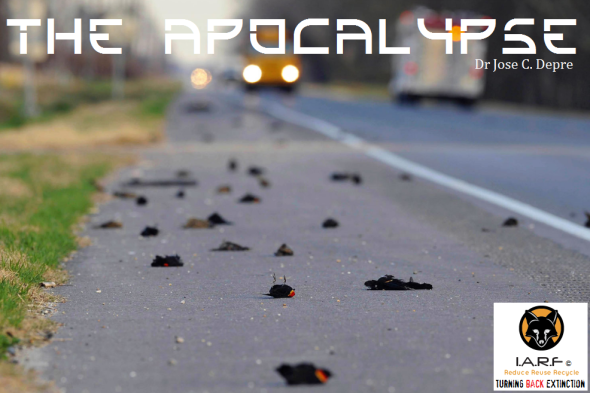
THE APOCALYPSE | WHAT ARE THEY TRYING TO TELL US?
Apocalypse
əˈpɒkəlɪps (Greek/Latin)
Noun: the Apocalypse: The complete final destruction of the world, as described in the biblical book of Revelation. “the bell’s ringing is supposed to usher in the Apocalypse”. An event involving destruction or damage on a catastrophic scale.
Zephaniah 3:8
“Therefore wait for Me,” declares the LORD, “For the day when I rise up as a witness Indeed, My decision is to gather nations, To assemble kingdoms, To pour out on them My indignation, All My burning anger; For all the earth will be devoured By the fire of My zeal.
Two days ago I wrote a brief extract in relation to some 1,300 birds assessed by the International Union for the Conservation of Nature (IUCN) Red List that scientists have predicted will be extinct come 2080. Many of these extinctions will be caused by habitat destruction, persecution, poaching, pet trade, lack of prey for birds to feed on, down to declining nesting areas destroyed by (increasing human population around the globe). These threats are what we know about, they are also documented within many articles I and third (non-related) organisations write about too.
However since the 1980’s scientists have been in a way trying to understand why birds die for en masse. Birds like many other animals don’t just die for no reason. Birds don’t decide to wake up one morning, then a few hours later commit suicide by hurtling to the ground at over 60mph thus dying instantly. Environmentalists from International Animal Rescue Foundation America have been documenting since 2010-2016 mass bird deaths around the globe.
Five days ago a meeting took place in NYC involving US - I.A.R.F environmentalists, bird watch groups in America, and nine scientists from Detroit and New York. This meeting was different from what we’d been planning; meaning we needed to get to the bottom of what was causing mass bird deaths around the globe, and were these deaths telling us something?. These deaths were not just as a result of habitat destruction, deforestation, human population increasing, industrialization, poaching or indiscriminate killing.
These deaths were caused as a result of something more sinister, a human problem maybe, something within the air, toxic pollution, aircraft noise, or as many scientists continue to bleat to the public “El Nino weather disturbances”?. The fact of the matter is, no scientist or governmental science group has yet established why so many birds are dropping from the skies, killing themselves, falling over dead, or as explained above flying into the ground at break next speed. The situation is so concerning that many environmental groups are now demanding answers from their local environmental governmental examiners. And as you may guess, El Nino has used as a silencing tool once again.
On Tuesday (03.08.2016) I contacted the Meteorological Office in Devon, Great Britain for more information with regards to what scientists have been stating from 2014-2016 are “El Nino events”. I myself didn’t 100% believe that we we’re going through an prolonged El Nino event. So in order for me to verify my concerns I had to speak to climatologists that were more clued up on this weather phenomenon than I was, and as I suspected, there hasn’t been as yet a “recorded El Nino event from the years of 2014-2016”, interesting!
El Nino:
“An irregularly occurring and complex series of climatic changes affecting the equatorial Pacific region and beyond every few years, characterized by the appearance of unusually warm, nutrient-poor water off northern Peru and Ecuador, typically in late December. The effects of El Niño include reversal of wind patterns across the Pacific, drought in Australasia, and unseasonal heavy rain in South America”
However even if an El Nino event was occurring, when I explained my concerns to the Devon board of climatologists they also agreed with me that birds don’t just drop from the skies, or suddenly die due to an El Nino event. Furthermore they also agreed with me; should any scientist use this weather event to explain why (100, 1000 or 10,000 birds just all of a sudden die), then them scientists are basically trying to keep the public calm. Interesting yet again.
Mass Bird Deaths:
The following information below relates to all recorded mass bird deaths around the globe from January 2016 to 28th July 2016. Avian bird flue deaths have been excluded from this report. Every single bird death listed hereto is unexplained. Avian influenza deaths have been excluded because the cause of death is known.
28th July 2016 - 300 sea birds have washed up dead since May in Washington State, America. 15th July 2016 - 3,500 ducks found dead along the river Palar in India. 14th July 2016 - Large number of sea birds washing up dead is ‘alarming’ in Victoria, Canada. 28th June 2016 - Hundreds of dead birds washing up along lake Erie in New York, America. 23rd June 2016 - Hundreds of dead birds found in fields ‘due to pesticides’ in Chandrapur, India. 2nd June 2016 - Large number of dead birds being found, ‘a mystery’ in Martins Ferry, Ohio, America. 10th May 2016 - Hundreds of snow geese found dead in Idaho, America.
9th May 2016 - 9,000 birds killed by huge hailstorm in Utah, America???. 9th May 2016 - 100 dead sea birds found washed up on beaches in El Tabito and Matanzas, Chile. 8th April 2016 - Dozens of dead birds found along a road in Fairfax County, Virginia, America. 7th April 2016 - 5,000 birds killed by storm in Jessore, Bangladesh???. 29th March 2016 - 100 dead birds found along I-5 in Redding, California, America. 22nd March 2016 - Dozens of dead birds found along a road in Elmira, New York, America. 16th March 2016 - Hundreds of dead crows found near Battle Creek in Michigan, America. 16th March 2016 - UPDATE: sea bird die off now up to 36,000 in Alaska, America. 4th March 2016 - Large number of dead sea birds washing up on beaches in Volusia, Florida, America. 26th February 2016 - 800 dead ducks removed from reservoirs in Caceres, Spain. 21st February 2016 - Dozens of dead birds found along a highway in Ohio, America. 18th February 2016 - Hundreds of dead sea birds found washed up in Trujillo, Peru.
18th February 2016 - Hundreds of birds fall dead from sky in Odessa, Ukraine???. 13th February 2016 - MASSIVE - 150,000 penguins die after giant iceberg becomes grounded in Antarctica. 10th February 2016 - Dozens of dead sea birds, plus other marine creatures found on a beach in Malibu, America. 4th February 2016 - Dozens of birds suddenly die in Wichita, Kansas, America. 4th February 2016 - Dozens of Pelicans dying, reason unknown on Grand Isle, Louisiana, America. 28th January 2016 - 22,000+ sea birds found dead, ‘biggest die off ever recorded’, along beaches Dead birds in alaskain Alaska, America. 28th January 2016 - Hundreds of sea birds found dead on a beach on Sea of Galilee, Israel. 25th January 2016 - Thousands of chickens killed by ‘mysterious disease’ in Kampong Thom, Cambodia. 6th January 2016 - Hundreds of dead birds found in Cueramaro, Mexico.
The report above is more than concerning, its actually horrifying. Fortunately many people have also sent to us videos and uploaded videos onto YouTube that clearly show (El Nino) is not to blame. Take a look at the video below, and explain to us how El Nino was responsible for these mass bird ‘suicide deaths’? The 2012 video report states:
“More than 100 birds — perhaps as many as 300, according to an eyewitness — were found Dec. 30, 2012, on and around Boyds Creek Road in Seymour, Tenn. While many of the birds were actually on the road, dozens more were found in a nearby field. As far as 60 yards away, individual birds, believed to be starlings, were found”…
Seymour, Tenn is located within the United States (Seymour, Tennessee). We did search through weather events relating to this video. On the day it was uploaded and from the sketchy media reports there were no freak weather occurrences, heavy rains, hail storms, tornadoes or anything to provide a reasonable explanation as to why so many starlings just all of a sudden died. Yet in few reports El Nino was blamed?
The report above (bird deaths) provides much startling data in relation to the Unites States too. From the start of January 2016 to July 28th 2016 most of the bird deaths recorded above are actually occurring within the United States. Furthermore we also have the so called “experts” that are providing their theories as to why so many birds are dying; in their own words “it only really happens once or twice every few years”. That’s absolute nonsense.
From 2005 a third party organisation aligned to I.A.R.F.A has been recording (and continues to record) mass bird deaths every year, and its not just one species neither. The video below touches up on everything that we already known about. Yet, it fails to touch up on what many of you don’t know. Watch the video please. as it does provide some proof, however the author is not projecting the real true story here as to why so many birds are dying.
“SO WHAT’S CAUSING THESE MASS DEATHS?”
Well firstly not everything is attributed to climate change, habitat destruction, or localized pollution. The author of the video above also seems to forget that America is not the only country that hosts millions of birds. For example he states that a mass die off of birds in Arkansas was caused by fireworks? While there may indeed be some truth to this theory, do we see the same mass bird die offs in England on Guy Fawkes night, Burns Night in Scotland, Chinese New Year, or Diwali? well the answer is, no we don’t. If we did we’d most certainly be documenting about it, and doing something to stop these events from harming our fauna.
From the tropics to the pole some of the worst bird declines and mass deaths are being witnessed within Africa, and Asia. North America’s bird populations “needed to keep the planets food crops in tact” are also declining to worrying levels never seen before. Vultures, raptors, eagles, swifts, swallows, colonies of sea birds, murres, puffins, down to shorebirds are all declining rapidly. Red knots in the Western Hemisphere are also vanishing ever so quickly. Sandpipers. spoonbills, pelicans, storks are among some of the migratory birds declining too.
BIRDS AND BIOCHEMISTRY
Today birds are telling us about new threats to the environment and potentially to human health in the coded language of biochemistry. Through analysis of the inner workings of birds’ cells, scientists have been deciphering increasingly urgent signals from ecosystems around the world. Like the fabled canaries that miners once thrust into coal mines to check for poisonous gases, birds provide the starkest clues in the animal kingdom about whether humans, too, may be harmed by toxic substances.
No birds to warn us = a threat to humans. And they prophesy what might happen to us as the load of carbon-based, planet-warming gases in the atmosphere and oceans climbs ever higher. Birds are the planets warning meters of danger, just as dogs warn us that intruders are nearing our property, and frogs inform us that the local rivers, ponds, and meadows have been polluted. Each species informs us of something.
Birds like rodents and amphibious creatures provide to us via their biochemistry coding, clues, and answers as to what is going on within the environment they are living in, and why they died. Birds that drop out of the sky during a (morning firework display)? that were allegedly scared would then show to scientists via their bloods, stress hormone changes. Neither of the birds in the United States that died as a result of fireworks - died as a result of fireworks, furthermore there is no PME evidence to back these claims up, just hearsay.
Dr Rachel Carson was the earliest and best known scientist to link the fate of birds to that of humans. Alerted by reports of sharp declines in birds of prey and songbirds, she began to examine the effects of the pesticide DDT. It was the first modern synthetic pesticide, in wide use after World War II to control mosquitoes and other insects. Her book Silent Spring, published in 1962—the title echoes the poet John Keats’s celebrated line “And no birds sing”—explained that DDT moved up through food chains, from the insects it was designed to kill to the creatures that ate them. It accumulated inexorably in tissues, organs, and fat in top predators such as peregrine falcons, ospreys, bald eagles, and pelicans.
By 1972, after public uproar, DDT was banned in the United States and eventually banned around the world except in malaria-prone countries, mostly in Africa. While DDT has indeed been taken out of service - there are other chemicals that are entering the food chain - and its birds like frogs and toads, newts and other amphibians that inform us when threats to humans are increasing due to chemicals making their way into or next to the food chain.
Interestingly - since the 1970’s DDT was banned right? Well just to give you an example of how powerful these chemicals are, and what threats they pose to human health, why not look up why songbirds are still dropping dead in St Louis, Michigan, next to an old chemical plant! So birds are still informing us that despite bans in place, and these chemicals are no longer being used, there are still threats to both humans and other animals from chemical residues. Eventually that factory will be demolished, but only because birds have told us in relation to PME tests on their carcasses.
Studies on birds exposed to chemicals from the 1980’s (onwards) have also shown us how these chemicals are altering human hormones and even cell changes. Causing cancers and other diseases and illnesses. More “human health scientists” are taking note of birds for clues or answers relating to why humans are falling ill, or dying. Take a look at how we found where the Ebola virus originated from in West Africa during the last outbreak, a single bat species. Today scientists can capture birds, test them, band them, let them go, and then catch them years later to see what’s changed in relation to “environmental chemical threats”. Birds also normally maintain relatively stable numbers, unlike small mammals. So when their populations take a dive, it means something noteworthy is going on.
“THAT’S WHAT BIRDS ARE TELLING US”
So as I have explained above, birds don’t just drop out of the sky for the sheer fun of it, and yes there are a wide number of problems such as habitat destruction, environmental disturbances, but more importantly - (pollution). Pollution has been linked to 90% of all bird deaths listed above from January to July 2016.

Image: Dead robin - St Louis, Michigan
The dead robin pictured above explained to scientists (via avian coding biochemistry) that the old disused chemical plant these birds and others nest and live next to was the primary cause for their death. Read more below:
http://www.environmentalhealthnews.org/ehs/news/2014/aug/michigan-ddt-cleanup Although its rather sad and unfortunate these birds died. They eventually told scientists via coding biochemistry why they died, and that has since provoked experts to now order the destruction of this old disused chemical plant, that was also causing serious health problems in humans living next to the chemical plant.
So when we begin to see mass bird deaths as explained above, these deaths must not be ignored. While the birds themselves aren’t singing to us that there is indeed a problem, their death[s] are indeed explaining to us that something isn’t quite right within the environment. The video below PROVES why we humans must ensure that our bird life populations around the globe are protected.
Failing this chemicals and toxins that are are not as yet harmful to us, but are to birds will eventually wreak havoc among the human and animal world. DDT was banned decades ago, yet its still causing illnesses, cancers, and mass bird deaths in America and around the globe.
“So when bird populations take a dive, it usually means something noteworthy is going on”
I find it quite alarming that within the past five years the large number of bird deaths at sea, and inland around the planet has simply been ignored, shrugged aside or scientists have basically given a half ass answer as to why they died.
SOMETHING IN THE AMERICAN AIR?
Following Britain’s Clean Air Act of 1956, it was reported that several species of birds returned to London. In 1986, Mexico City’s air pollution levels were so severe that various news sources reported birds falling from the sky in droves. In 2013, particulate matter from nearby forest fires shrouded Singapore so completely that locals found dead birds near their homes.
Now lets take a look at a handful OF UNITED STATES BIRD DEATHS, DEATHS THAT HAVE BEEN TELLING SCIENTISTS THAT SOMETHING ISN’T QUITE RIGHT:
- 9th May 2016 - 9,000 birds killed by huge hailstorm in Utah, America???
- Dozens of dead birds found along a road in Fairfax County, Virginia, America. 7th April 2016
- March 2016 - 100 dead birds found along I-5 in Redding, California, America
- Dozens of dead birds found along a road in Elmira, New York, America
- 16th March 2016 - Hundreds of dead crows found near Battle Creek in Michigan, America
- 4th February 2016 - Dozens of birds suddenly die in Wichita, Kansas, America
“Mexico City’s air pollution levels were so severe that various news sources reported birds falling from the sky in droves”
If this article doesn’t concern you then ignore it, move on, and do not question it. I.A.R.F documents every year on mass animal deaths, these deaths are all recorded, and then investigated. Finally, North and South American bird population are declining to worrying levels. As you can see above the report in relation to LONDON and MEXICO resulted in actions being taken to preserve life.
However - take our two winged friends away, and you’ve a whole lot of nasties to contend with.
“OPEN YOUR EYES”
Dr Jose C. Depre.
PhD. MEnvSc. BSc(Hons) Botany, PhD(NeuroSci) D.V.M. Environmental & Human Science
Endangered Species Monday: Bombus occidentalis |Extinction is Imminent.
Endangered Species Monday: Bombus occidentalis
“1/3 bites of food we eat comes from a plant that was pollinated by a bee”
What are we humans doing to Planet Earth?, We are destroying so many pollinating animals, that soon they’ll be none left. When or if that day occurs, when there are no more pollinators, we ourselves will be fighting to stay alive, can you imagine that? Human extinction is slowly in the making… …No matter how many vegans or vegetarians there are, we all require plants. No plants = No life!
That’s a Scientific Fact of Life!
Dr Jose Depre
This Monday’s Endangered Species Post (E.S.P) I document on the Western Bumble Bee. Scientifically identified as Bombus occidentalis this particular species of bee is listed as (vulnerable), and is now nearing complete extinction within the wild, despite conservation efforts aimed at reducing dangers, things certainly are not looking good for the bee, or crops the species pollinates either. Image credits: Rich Hatfield
The species was identified back in 1858 by Dr Edward Lee Greene, Ph.D, (August 10, 1843 – November 10, 1915) was an American botanist known for his numerous publications including the two-part Landmarks of Botanical History and the naming or redescribing of over 4,400 species of plants in the American West.
Endemic to: Canada (Alberta, British Columbia, Northwest Territories, Saskatchewan, Yukon); United States (Alaska, Arizona, California, Colorado, Idaho, Montana, Nebraska, Nevada, New Mexico, Oregon, South Dakota, Utah, Washington, and Wyoming). To date we still don’t know what the “exact current rate of decline is”, or even if the Western Bumble Bee is going to be with us within the next decade. Its ‘likely that based on current surveys the species will be extinct within the next 10 years (max)”.
Since 2008-2014 there has been quite a significant rate of decline st 11%-12%, sparking concerns that the Western Bumble Bee ‘may eventually be listed as critically endangered’ within the United States and Canada. Scientists confirmed that in one area which is [unknown], possibly the United States via field surveys the species was not found during the years of 2003-2007 (which is of course quite concerning), especially when the species is a major pollinator, and has been seen only in very low numbers at (one to seven per year) each year from 2008 to 2014.
A study conducted focusing on ‘range decline’ relating to some eight separate species native to the United States, showed that the Western Bumble Bee species alone had decreased in population size within its (range), by some 28% (EST) between the years of 2007-2008. A further study conducted by conservation scientists concluded that by 2007-2009 surveys detected the species only throughout the Intermountain West and Rocky Mountains; it was largely absent from the western portion of its range.
Further declines have been reported within the [US] states’ of Oregon and Washington, however populations seem to be somewhat stable within (northeastern Oregon). Populations are also to a degree stable within Alaska and the Yukon. Average decline for this species was calculated by averaging the change in abundance, persistence, and EOO.
- Current range size is estimated to be at some 77.96%
- Persistence in current range relative to historic occupancy: 72.56%
- Current relative abundance relative to historic values: 28.51%
- Average decline: 40.32%
From viewing all data records I can confirm that the (exact rate of decline) within the species range, and its persistence total some 20%, with a 70% rate of decline in ‘abundance’. Surveys have also proven the this decades rate of decline is bar far lower than the last decades, which again raises some rather large concerns about a near future extinction occurring.
Image: Western Bumble Bees’ extant zones.
In the past, B. occidentalis was commercially reared for pollination of greenhouse tomatoes and other crops in North America. Commercial rearing of this species began in 1992, with two origins. Some colonies were produced in rearing facilities in California by a company which imported the technology for rearing bumble bees and applied it to rearing B. occidentalis locally in California.
This same year, a distributor for a competitor which did not have rearing facilities in North America at the time was granted permits by the US Department of Agriculture – Animal and Plant Health Inspection Service (USDA-APHIS) for a three year window of time (1992-1994) to export queens of B. occidentalis and B. impatiens to European rearing facilities for colony production.
Following rearing, these colonies were then shipped back to the U.S. for commercial pollination. In 1997, commercial producers began experiencing problems with disease (Nosema) in the production of B. occidentalis. Eventually, the availability of B. occidentalis became critically low, and western crop producers who had become dependent on pollination provided by this species began requesting that APHIS allow the shipment and use of B. impatiens in western states.
In 1998, the USDA-APHIS issued permits to allow B. impatiens to be used in the western U.S. However, within a few years, the USDA-APHIS stopped regulating the interstate movement of bumble bees altogether, citing their lack of regulatory authority. Bombus occidentalis is no longer bred and sold commercially and B. impatiens is used widely in the western U.S. One has to wonder though that since the the US Government stopped granting permits for Bombus occidentalis mostly due to species decline, primarily due to human ignorance, will the same rate of decline now be seen with the species B. impatiens?
Currently to date the only ‘known conservation actions that are under way is that of management, research and surveys’, meanwhile its likely that come the next decade we’ll have lost the species due to a lack of improving/increasing populations, and habitat while failing to decrease disease and virus.
THREATS
Populations of this declining species have been associated with higher levels of the microsporidian Nosema bombi and reduced genetic diversity relative to populations of co-occurring stable species. The major decline of the subgenus Bombus was first documented in B. occidentalis, as Nosema nearly wiped out commercial hives, leading to the cessation of commercial production of this species. Wild populations crashed simultaneously and the closely related B. franklini has been pushed to the brink of extinction.
However, Koch and Strange (2012) found high levels of infestation by Nosema in interior Alaska where this bumble bee was still quite common. In addition to disease, this species is faced with numerous other stressors including habitat loss and alteration due to agricultural intensification, urban development, conifer encroachment (resulting from fire suppression), grazing, logging and climate change.
Modifications to bumble bee habitat from over grazing by livestock can be particularly harmful to bumble bees by removing floral resources, especially during the mid-summer period when flowers may already be scarce. In addition, livestock may trample nesting and overwintering sites, or disrupt rodent populations, which can indirectly harm bumble bees. Indirect effects of logging (such as increased siltation in runoff) and recreation (such as off-road vehicle use) also have the potential to alter meadow ecosystems and disrupt B. occidentalis habitat.
Additional habitat alterations, such as conifer encroachment resulting from fire suppression, fire, agricultural intensification, urban development, and climate change may also threaten B. occidentalis. Insecticides, which are designed to kill insects directly, and herbicides, which can remove floral resources, both pose serious threats to bumble bees. Of particular concern are neonicotinoids, a class of systemic insecticides whose toxins are extraordinarily persistent, are expressed in the nectar and pollen of plants (and therefore are actively collected by bumble bees), and exert both lethal and sublethal effects on bumble bees.
Since B. occidentalis has recently undergone a dramatic decline in range and relative abundance, reduced genetic diversity and other genetic factors make this species especially vulnerable to extinction, and may lead to increased pathogen susceptibility. Recent research indicates that populations of B. occidentalis have lower genetic diversity compared to populations of co-occurring stable species.
It is therefore regrettable, that despite research, management and surveys - extinction is imminent, when though, we simply don’t know, however when it does happen, it means that yet another pollinator that we humans and animals depend on will be gone for good.
Image: Female B. occidentalis
Humans will never learn or understand just how critically important our wildlife is, until its gone. They’ll then be fighting over themselves, fighting to stay alive. By that time, human extinction will already be in the process.
Dr Jose C. Depre
Chief Environmental & Botanical Officer.
Follow me on Twitter here: https://twitter.com/josedepre11
VINPEARL LAUNCHES SMEAR CAMPAIGN | NAUGHTY.
WHERE DID YOU PURCHASE YOUR ANIMALS FROM AGAIN?
The Vinpearl Group fronted by Viet Nam’s most richest man has recently launched a very humorous smear campaign, AGAINST I.A.R.F. Now we don’t normally play smear, or even dirty, but if we’re going to play smear lets pull the big clangers out of the hat here.
WHO FROM THE VINPEARL GROUP PURCHASED HUNTING ANIMALS?
We recently ran a trace on where Vinpearl recently purchased some 330+ animals from in South Africa. No, it wasn’t from Harrods, although that wouldn’t surprise us to be honest. The so called ‘professional group’ fronted by some rather illiterate journalists seems to be forgetting that whilst their BIG BOSS MAN may have money, we have experience and some 8.9 million supporters to share share that experience with. Opps.
SHINGALANA LION & RHINO GAME RESERVE
Who in their right mind purchases animals from hunters, knowing that the money given to them hunters will purchase more animals to kill? BACK in DECEMBER 2015 - The Vinpearl Group purchased lions, tigers, kudu, monkeys, and zebra from SHINGALANA LION & RHINO GAME RESERVE, now did the Vinpearl Group inform their ‘paid journalists to look that one up’? Moreover why are paid ‘Vinpearl journalists supporting killers that support others killers’?
Image: Thanh Chu readying animals for Vinpearl transportation.
Now what does Thanh Chu (pictured above) and Ben Tran (pictured below), have in common with the hunting lodge that supplied countless diseased animals to the Vinpearl Group? Lets take a look.
Image: Ben Tran overseeing the shipment of animals from South Africa to Vinpearl.
Ben Tran and Mme Chị Van Anh Le (both of which are NOW hiding their data online quicker than you can say boo to a ghost), were the two main players that done dealings with the ‘hunting lodge above’. Not very professional is it? And before Ben Tran or even his sidekick denies knowing one another, or even the hunter they purchased animals off with the help of Viet Nam’s most richest man, think again!
Image: Van Thanh Chu who works for Frikkie Jacobs
Now who is Frikkie Jacobs dare we ask? Unfortunately for the Vinpearl Group, Frikkie Jacobs is one of many sadistic and quite narcissistic hunters that the so called ‘Viet Nam’s prominent richest man purchased animals from. The money that went into the sales of them animals, will now go into killing more animals as can be seen in the image above (top screen). Not very gentleman like now is it? Sigh.
Image: SHINGALANA LION & RHINO GAME RESERVE
Viet Nam’s richest man funds hunters.
Now okay. Viet Nam’s most richest man probably didn’t directly place money into the pockets of hunters and demanded they hunted more animals. What Mr Pham Nhat Vuong did do though is provide money to Mr Tran, Mme Chị Van Anh Le, and Mr Chu Dang Khoa to purchase animals from SHINGALANA LION & RHINO GAME RESERVE. That money has sadly gone directly into the pockets of hunters, that will breed more animals, hunt more animals and continue to cycle of trophy hunting.
Now be quick. All you Vinpearl paid journalists may want to check our claims up, they’re fast vanishing, and its likely that more and more data will vanish offline.
Thankfully we hold reams and reams of fast soon to be vanishing data.
When you try and smear us with nonsense, be careful, because we’d already have looked you up, spat you out, and moved on.
Have a nice day.
Anti Vinpearl Journalist.

